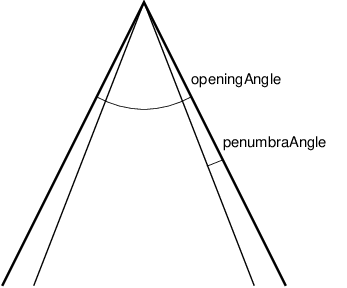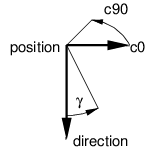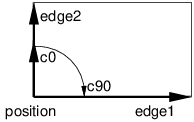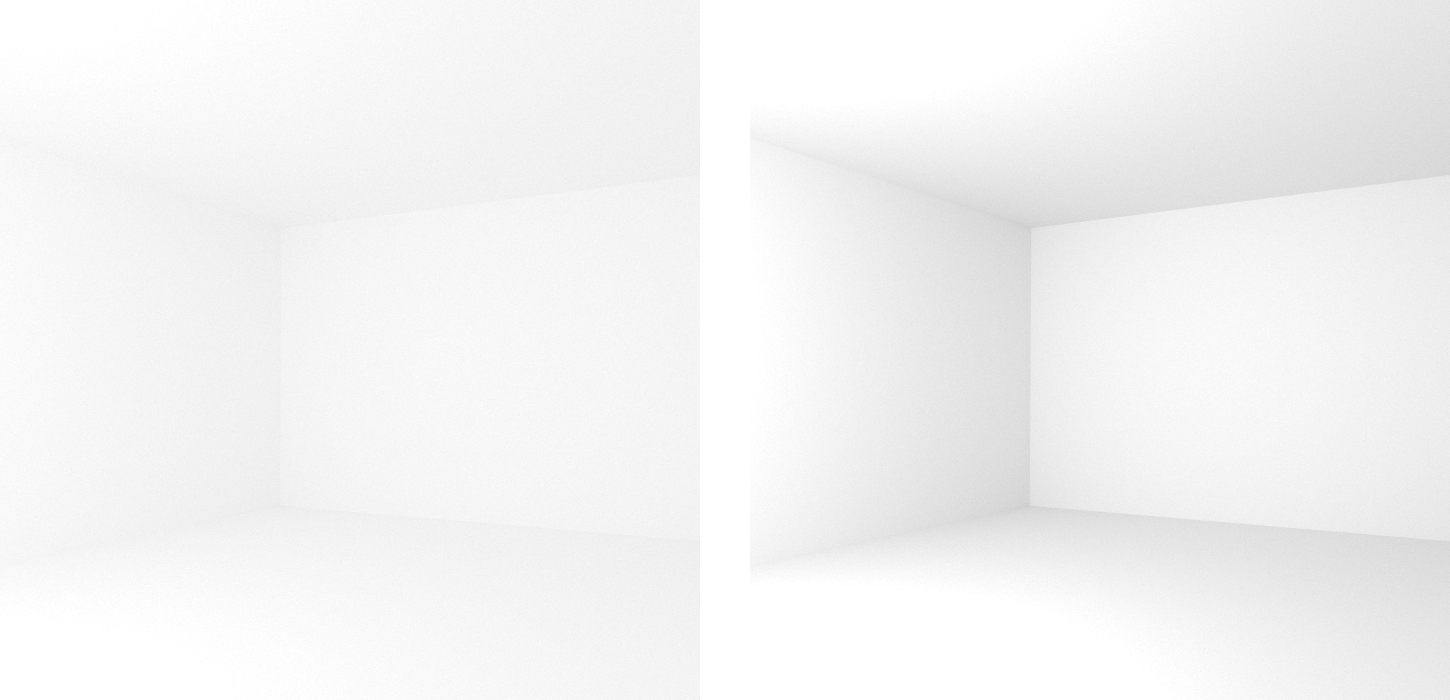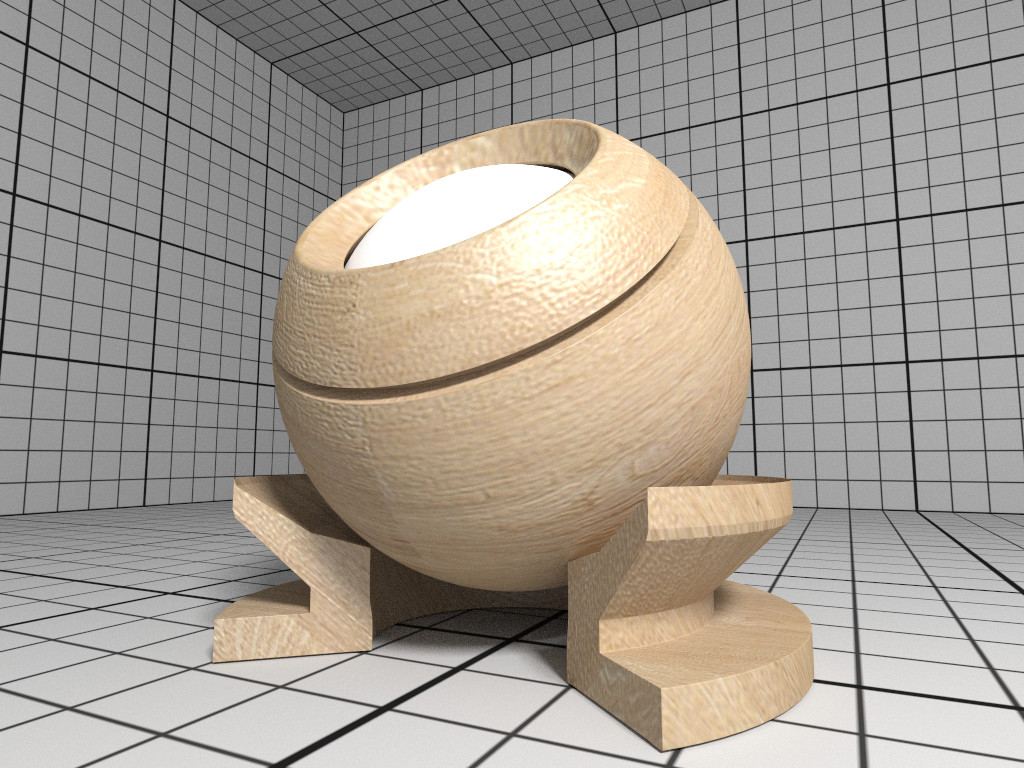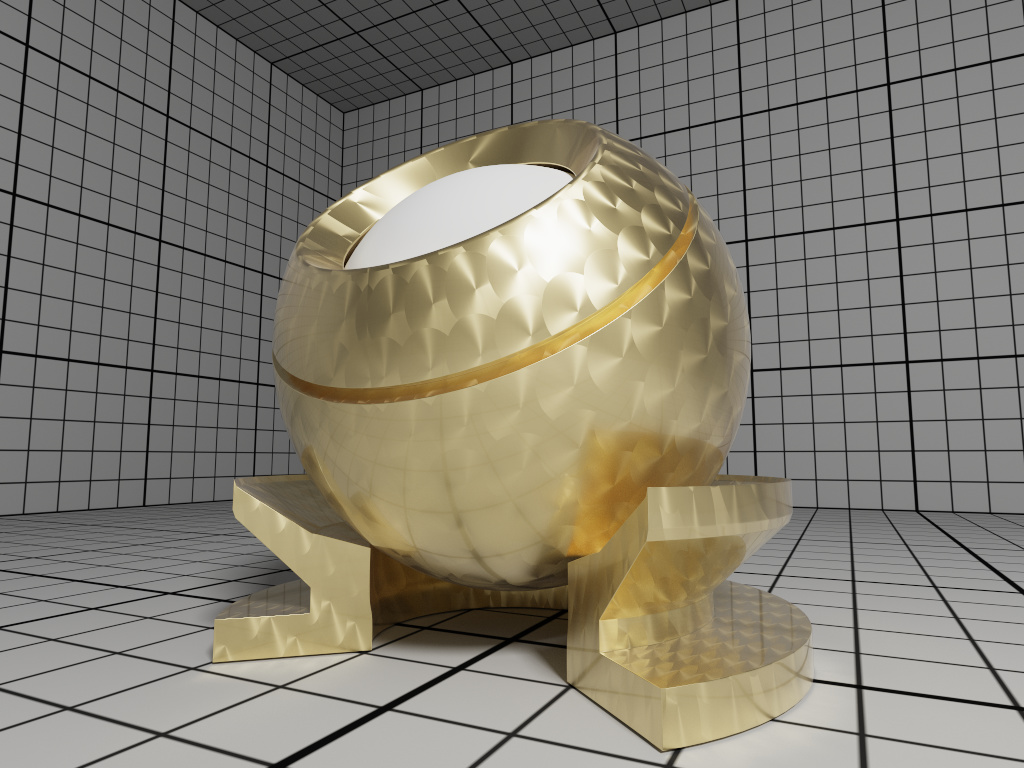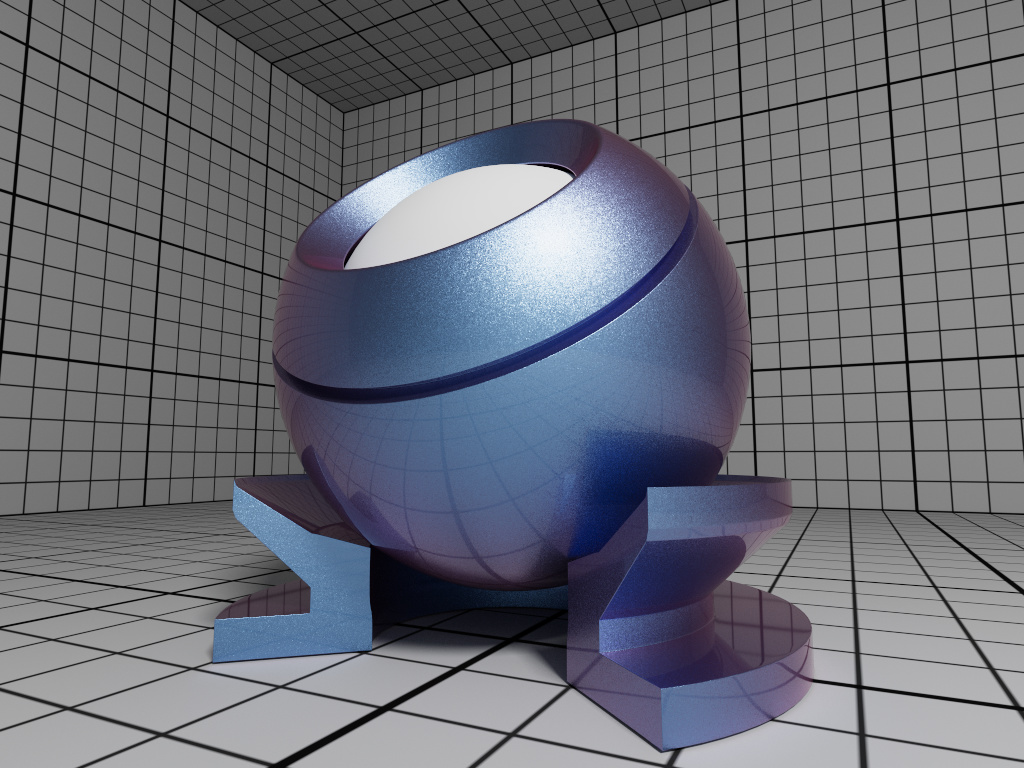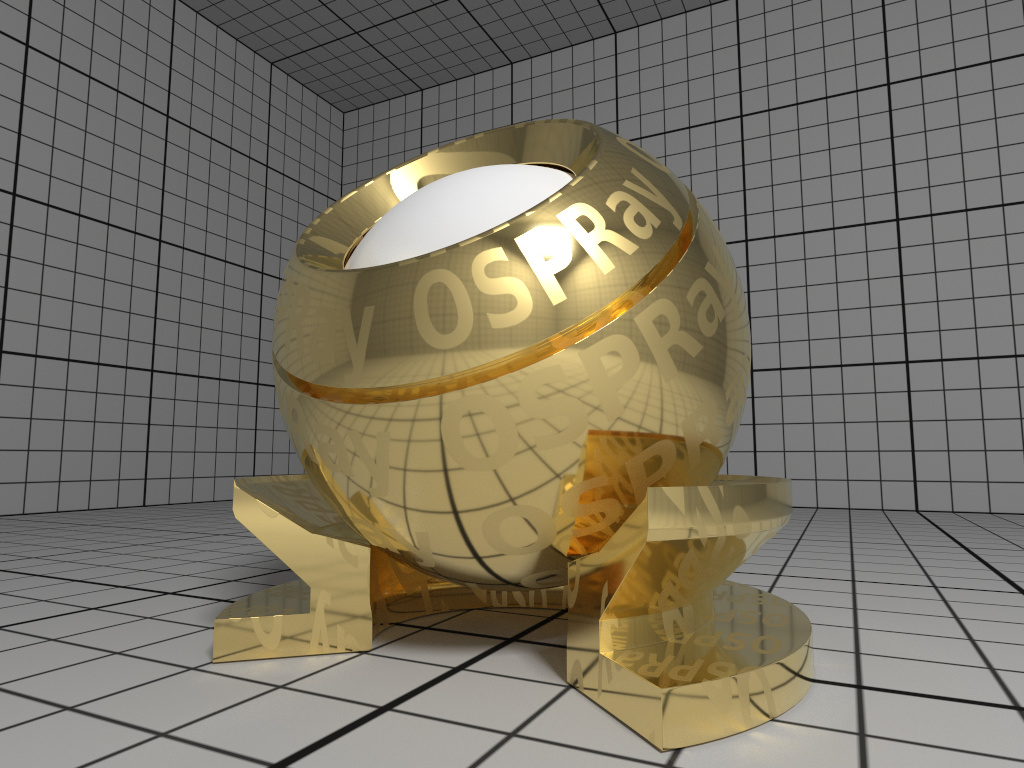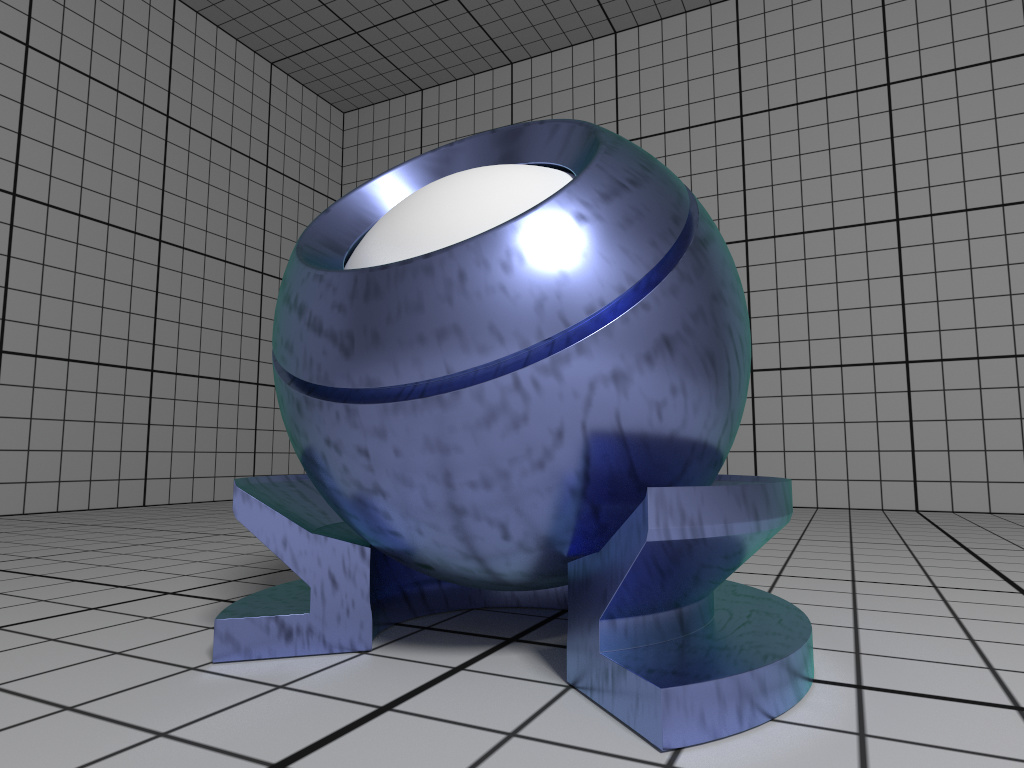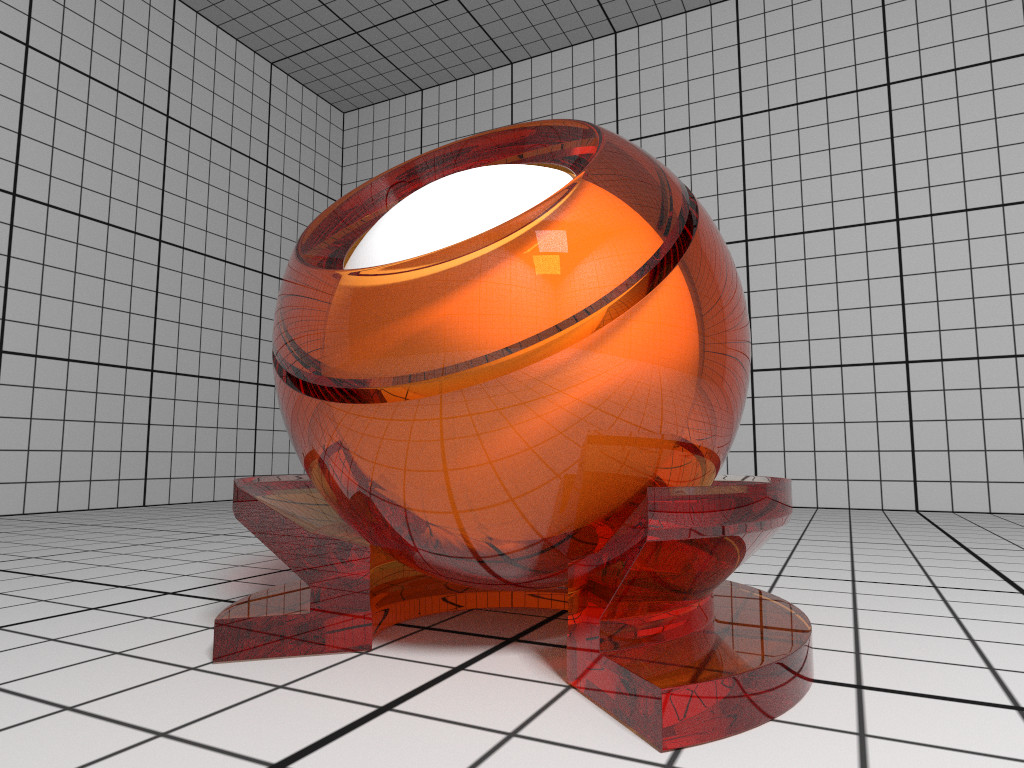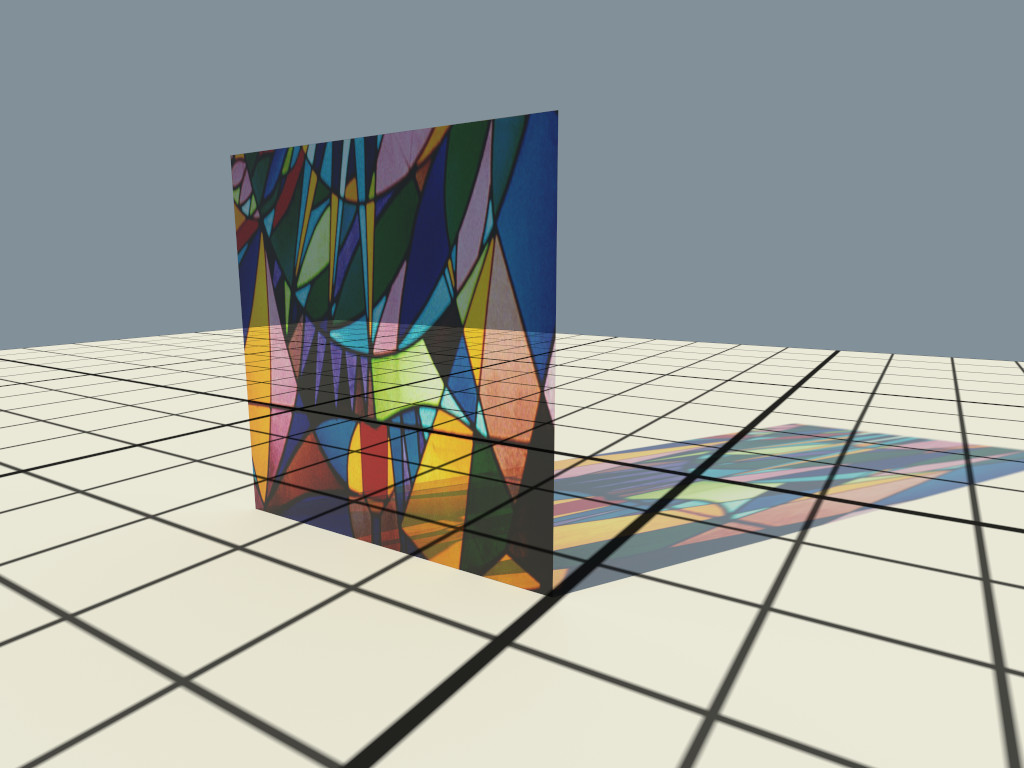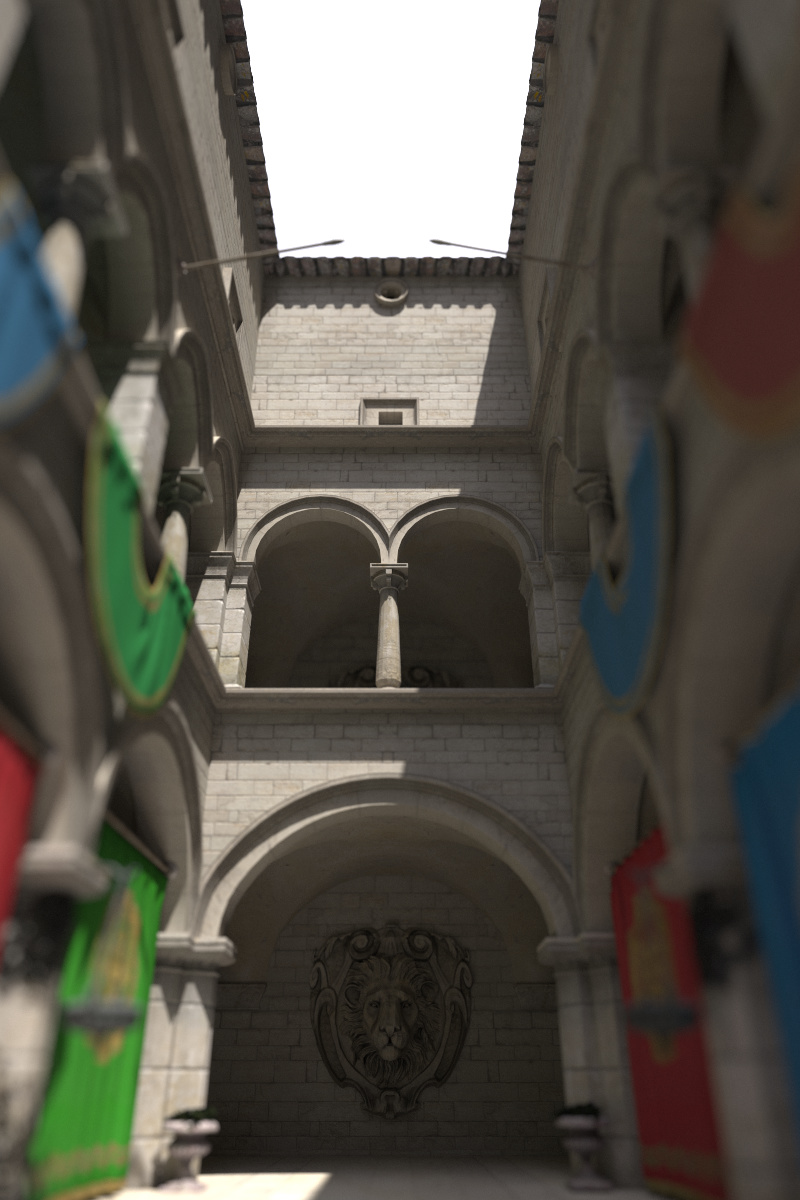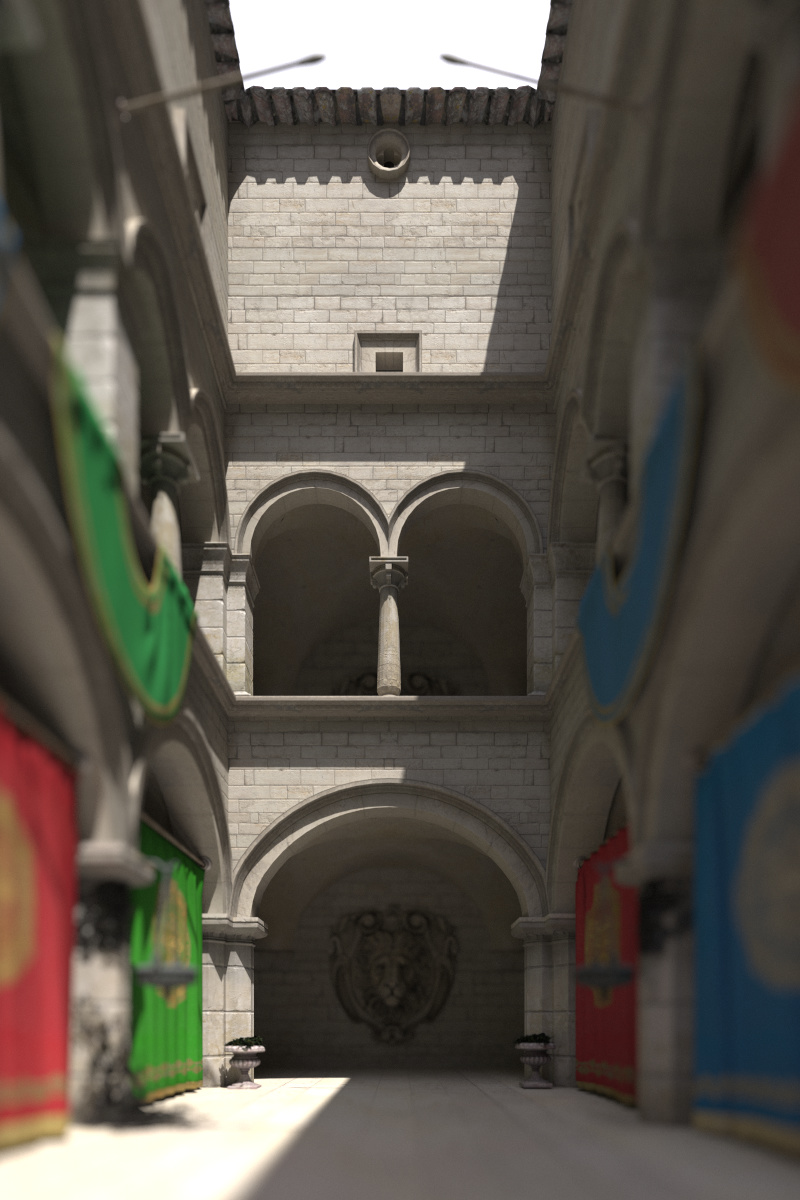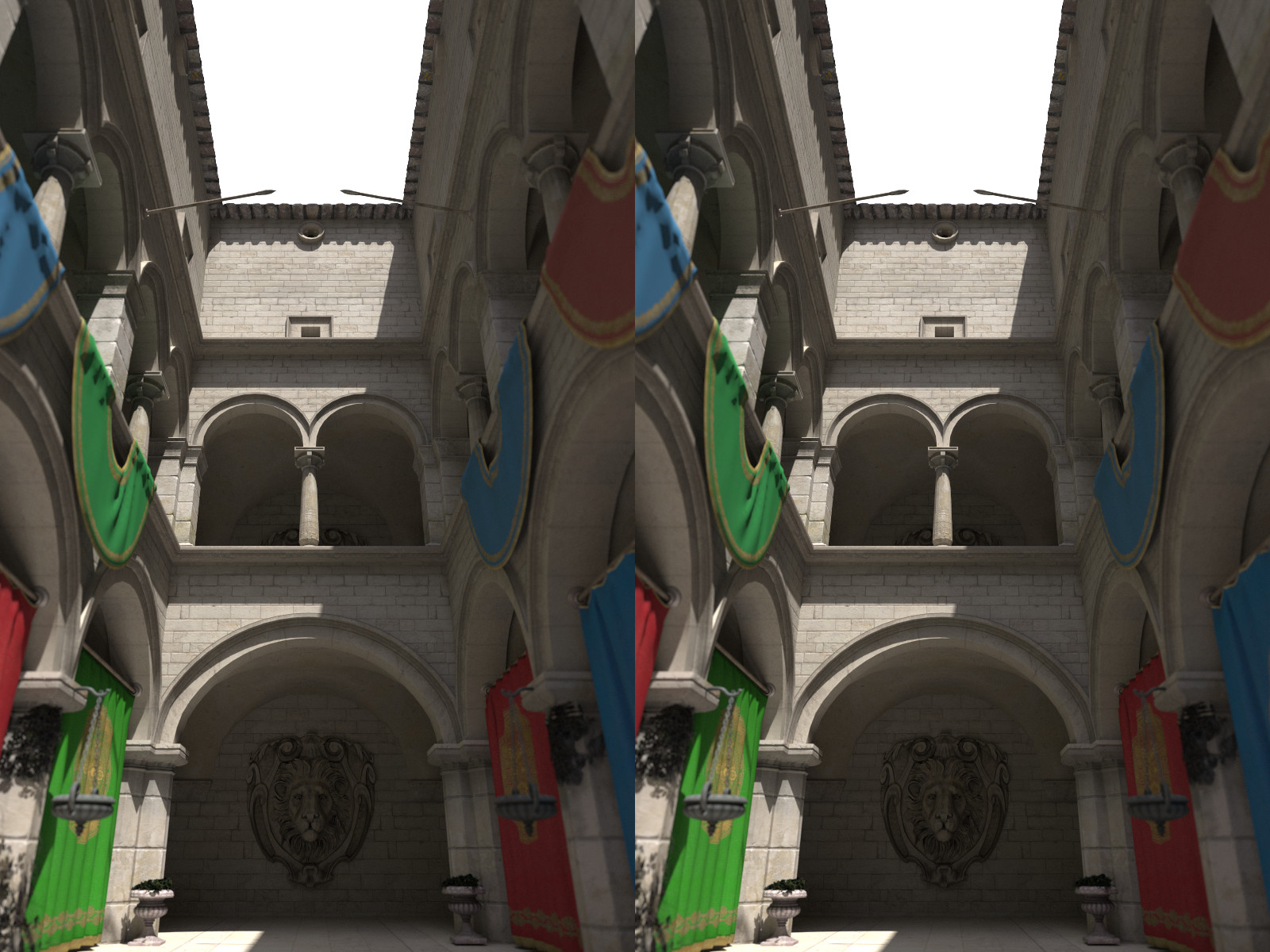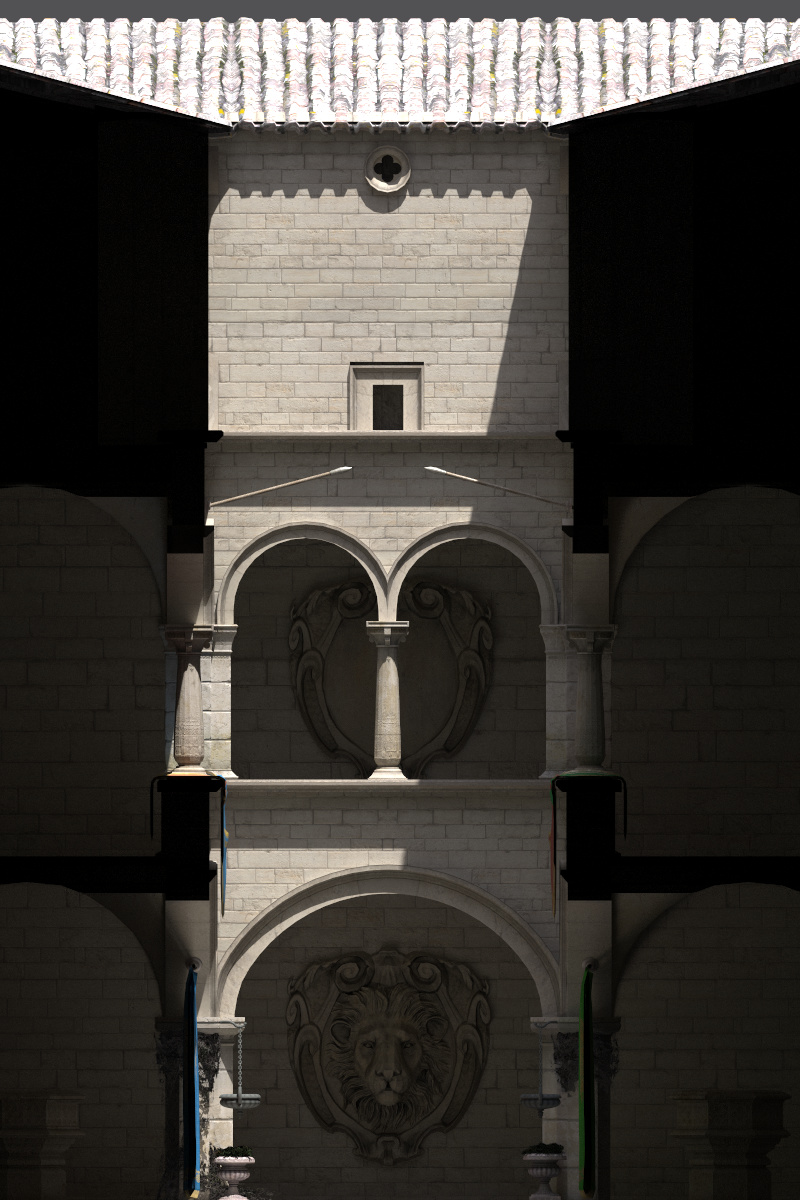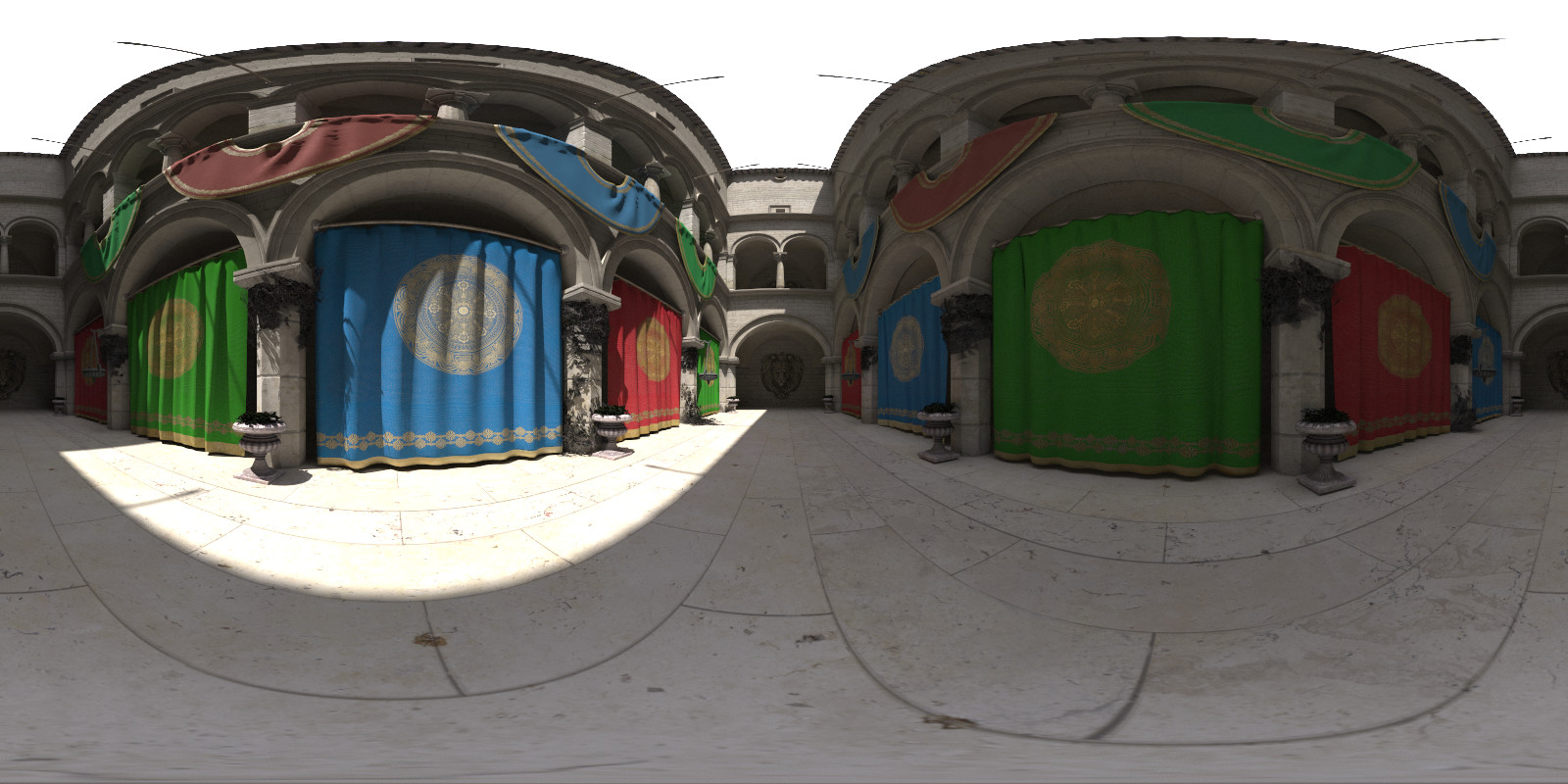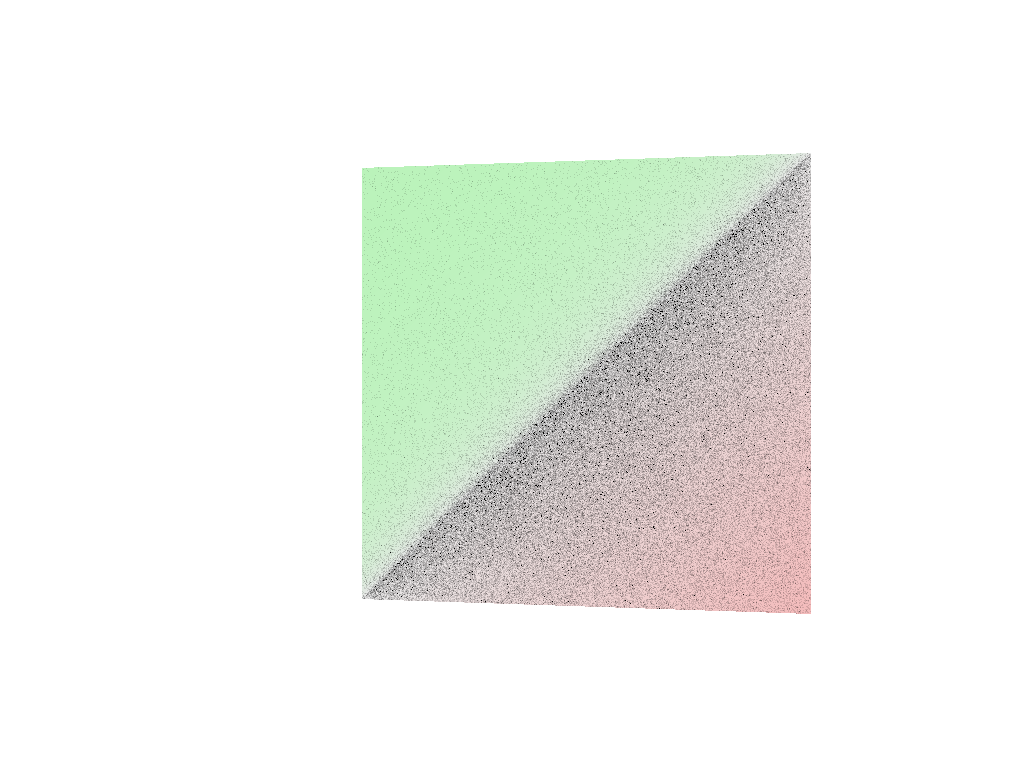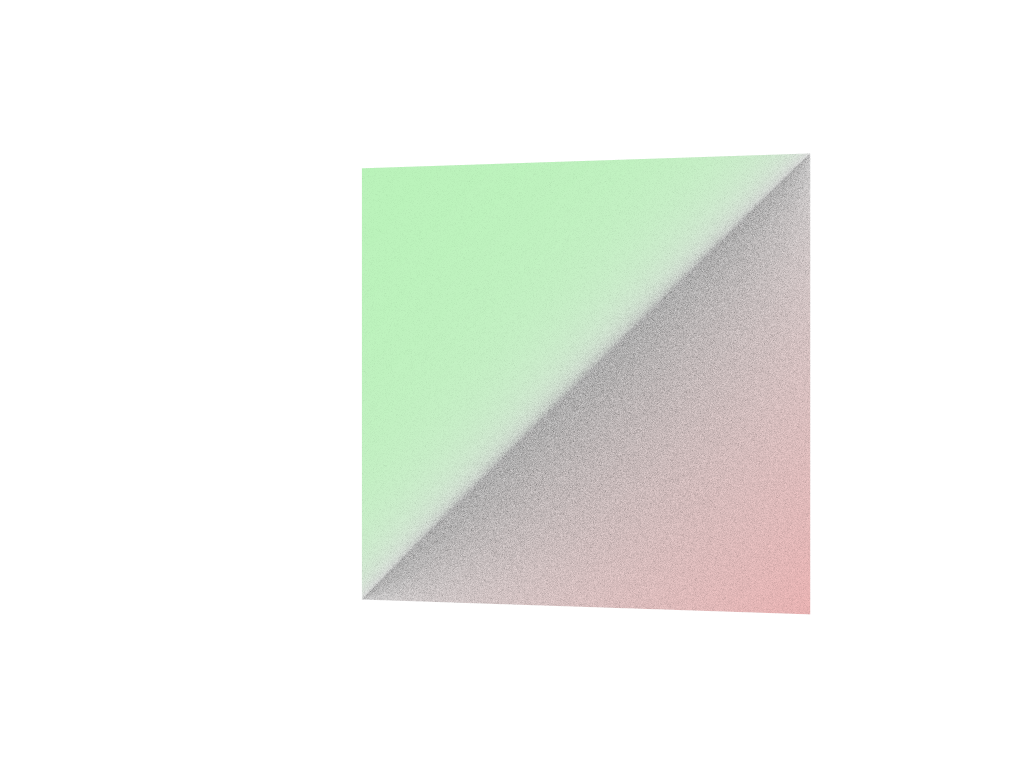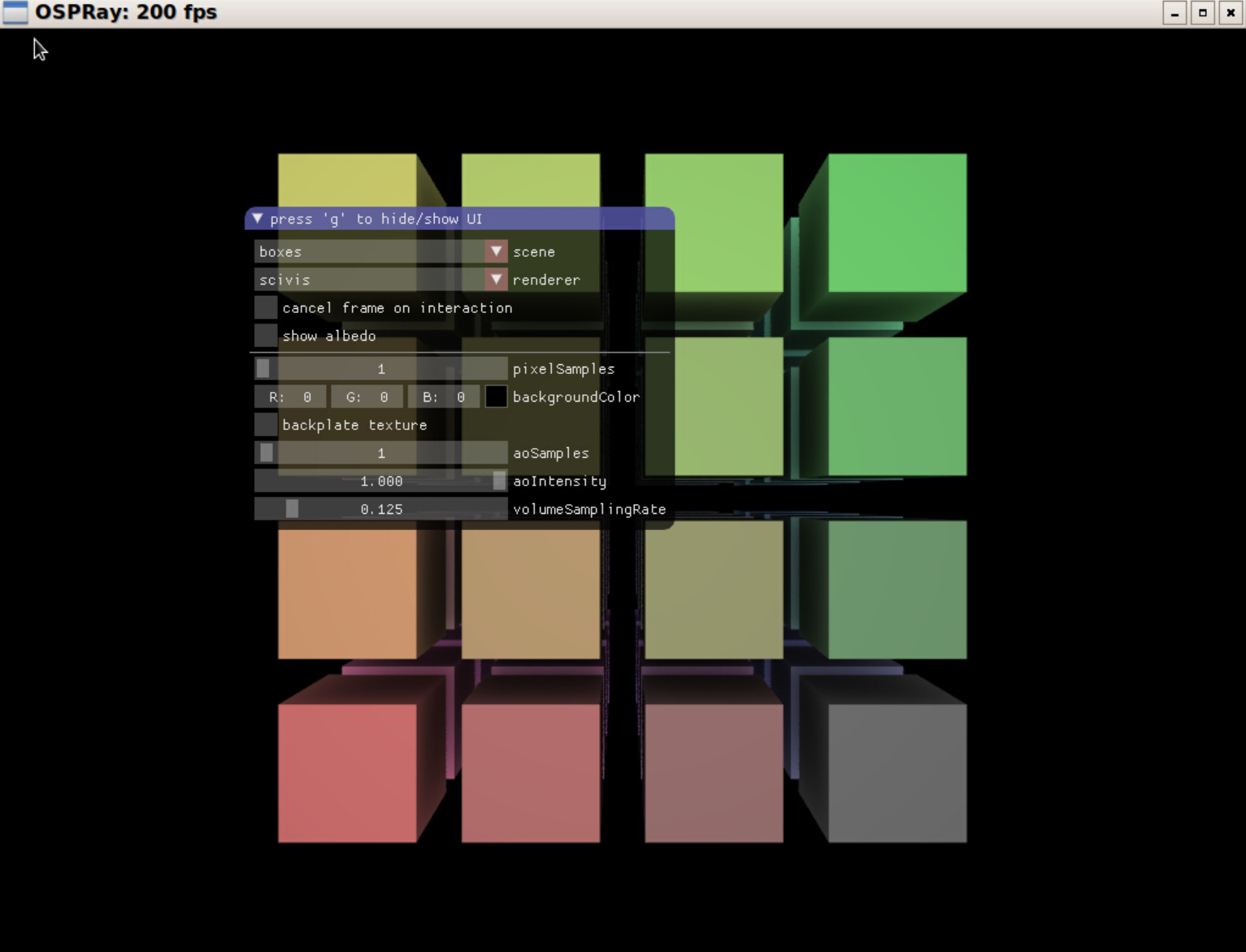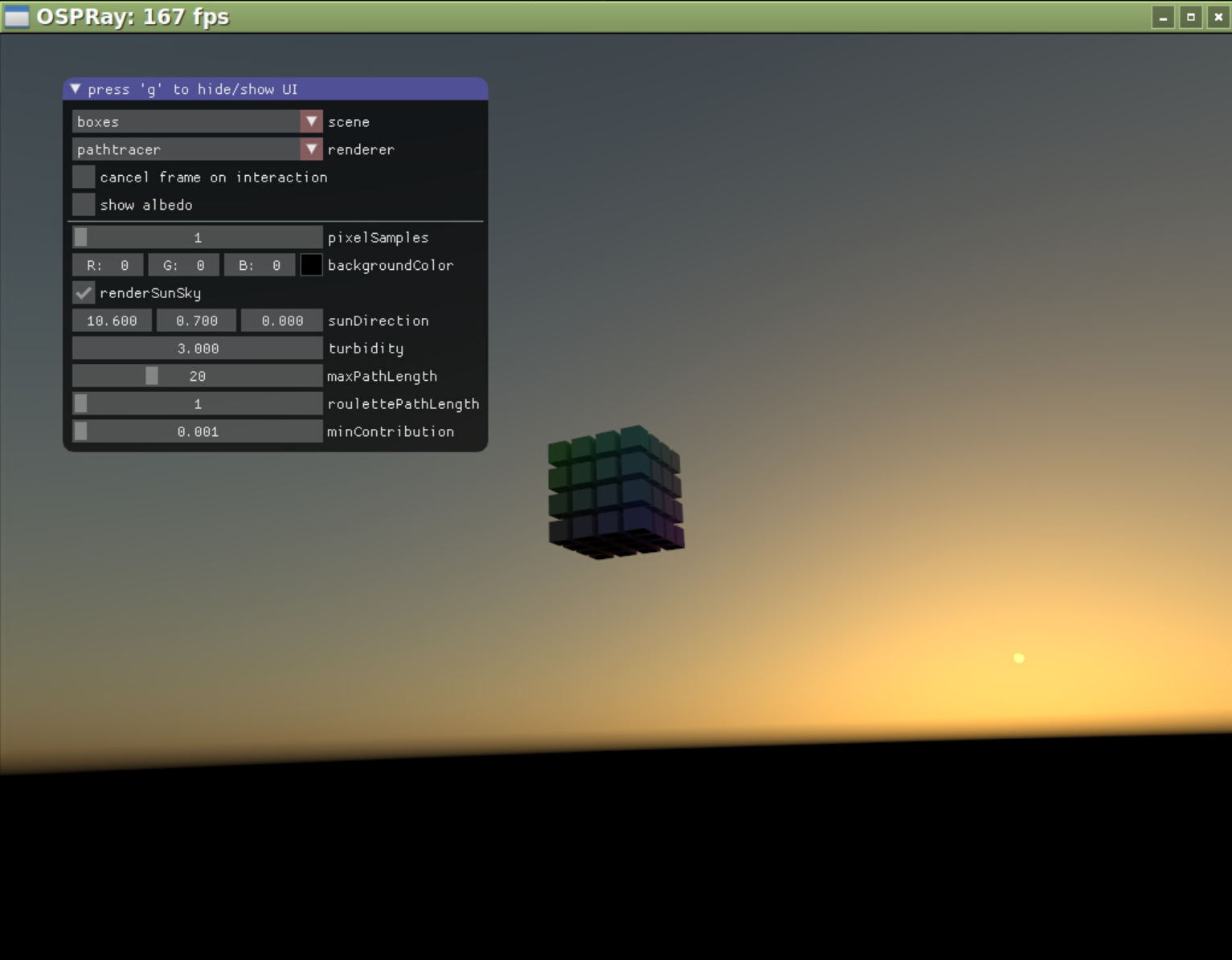This is release v2.1.1 of Intel® OSPRay. For changes and new features see the changelog. Visit http://www.ospray.org for more information.
Intel OSPRay is an open source, scalable, and portable ray tracing engine for high-performance, high-fidelity visualization on Intel Architecture CPUs. OSPRay is part of the Intel oneAPI Rendering Toolkit and is released under the permissive Apache 2.0 license.
The purpose of OSPRay is to provide an open, powerful, and easy-to-use rendering library that allows one to easily build applications that use ray tracing based rendering for interactive applications (including both surface- and volume-based visualizations). OSPRay is completely CPU-based, and runs on anything from laptops, to workstations, to compute nodes in HPC systems.
OSPRay internally builds on top of Intel Embree and ISPC (Intel SPMD Program Compiler), and fully exploits modern instruction sets like Intel SSE4, AVX, AVX2, and AVX-512 to achieve high rendering performance, thus a CPU with support for at least SSE4.1 is required to run OSPRay.
OSPRay is under active development, and though we do our best to guarantee stable release versions a certain number of bugs, as-yet-missing features, inconsistencies, or any other issues are still possible. Should you find any such issues please report them immediately via OSPRay’s GitHub Issue Tracker (or, if you should happen to have a fix for it,you can also send us a pull request); for missing features please contact us via email at ospray@googlegroups.com.
Join our mailing list to receive release announcements and major news regarding OSPRay.
The latest OSPRay sources are always available at the OSPRay GitHub
repository. The default master
branch should always point to the latest bugfix release.
OSPRay currently supports Linux, Mac OS X, and Windows. In addition, before you can build OSPRay you need the following prerequisites:
-
You can clone the latest OSPRay sources via:
git clone https://github.com/ospray/ospray.git -
To build OSPRay you need CMake, any form of C++11 compiler (we recommend using GCC, but also support Clang, MSVC, and Intel® C++ Compiler (icc)), and standard Linux development tools. To build the interactive tutorials, you should also have some version of OpenGL and GLFW.
-
Additionally you require a copy of the Intel® SPMD Program Compiler (ISPC), version 1.9.1 or later. Please obtain a release of ISPC from the ISPC downloads page. The build system looks for ISPC in the
PATHand in the directory right “next to” the checked-out OSPRay sources.1 Alternatively set the CMake variableISPC_EXECUTABLEto the location of the ISPC compiler. Note: OSPRay is incompatible with ISPC v1.11.0. -
OSPRay builds on top of a small C++ utility library called
ospcommon. The library provides abstractions for tasking, aligned memory allocation, vector math types, among others. For users who also need to build ospcommon, we recommend the default the Intel® Threading Building Blocks (TBB) as tasking system for performance and flexibility reasons. Alternatively you can set CMake variableOSPCOMMON_TASKING_SYSTEMtoOpenMPorInternal. -
OSPRay also heavily uses Intel Embree, installing version 3.8.0 or newer is required. If Embree is not found by CMake its location can be hinted with the variable
embree_DIR. -
OSPRay also heavily uses Intel Open VKL, installing version 0.9.0 or newer is required. If Open VKL is not found by CMake its location can be hinted with the variable
openvkl_DIR. -
OSPRay also provides an optional module that adds support for Intel Open Image Denoise, which is enabled by
OSPRAY_MODULE_DENOISER. When loaded, this module enables thedenosierimage operation. You may need to hint the location of the library with the CMake variableOpenImageDenoise_DIR.
Depending on your Linux distribution you can install these dependencies
using yum or apt-get. Some of these packages might already be
installed or might have slightly different names.
Type the following to install the dependencies using yum:
sudo yum install cmake.x86_64
sudo yum install tbb.x86_64 tbb-devel.x86_64
Type the following to install the dependencies using apt-get:
sudo apt-get install cmake-curses-gui
sudo apt-get install libtbb-dev
Under Mac OS X these dependencies can be installed using MacPorts:
sudo port install cmake tbb
Under Windows please directly use the appropriate installers for CMake, TBB, ISPC (for your Visual Studio version) and Embree.
For convenience, OSPRay provides a CMake Superbuild script which will pull down OSPRay’s dependencies and build OSPRay itself. By default, the result is an install directory, with each dependency in its own directory.
Run with:
mkdir build
cd build
cmake [<OSPRAY_SOURCE_LOC>/scripts/superbuild]
cmake --build .
On Windows make sure to select the non-default 64bit generator, e.g.
cmake -G "Visual Studio 15 2017 Win64" [<OSPRAY_SOURCE_LOC>/scripts/superbuild]
The resulting install directory (or the one set with
CMAKE_INSTALL_PREFIX) will have everything in it, with one
subdirectory per dependency.
CMake options to note (all have sensible defaults):
CMAKE_INSTALL_PREFIX : will be the root directory where everything gets installed.
BUILD_JOBS
: sets the number given to make -j for parallel builds.
INSTALL_IN_SEPARATE_DIRECTORIES : toggles installation of all libraries in separate or the same directory.
BUILD_EMBREE_FROM_SOURCE : set to OFF will download a pre-built version of Embree.
BUILD_OIDN_FROM_SOURCE : set to OFF will download a pre-built version of Open Image Denoise.
BUILD_OIDN_VERSION : determines which version of Open Image Denoise to pull down.
For the full set of options, run:
ccmake [<OSPRAY_SOURCE_LOC>/scripts/superbuild]
or
cmake-gui [<OSPRAY_SOURCE_LOC>/scripts/superbuild]
Assuming the above requisites are all fulfilled, building OSPRay through CMake is easy:
-
Create a build directory, and go into it
mkdir ospray/build cd ospray/build(We do recommend having separate build directories for different configurations such as release, debug, etc.).
-
The compiler CMake will use will default to whatever the
CCandCXXenvironment variables point to. Should you want to specify a different compiler, run cmake manually while specifying the desired compiler. The default compiler on most linux machines isgcc, but it can be pointed toclanginstead by executing the following:cmake -DCMAKE_CXX_COMPILER=clang++ -DCMAKE_C_COMPILER=clang ..CMake will now use Clang instead of GCC. If you are ok with using the default compiler on your system, then simply skip this step. Note that the compiler variables cannot be changed after the first
cmakeorccmakerun. -
Open the CMake configuration dialog
ccmake .. -
Make sure to properly set build mode and enable the components you need, etc.; then type ’c’onfigure and ’g’enerate. When back on the command prompt, build it using
make -
You should now have
libospray.[so,dylib]as well as a set of example applications.
On Windows using the CMake GUI (cmake-gui.exe) is the most convenient
way to configure OSPRay and to create the Visual Studio solution files:
-
Browse to the OSPRay sources and specify a build directory (if it does not exist yet CMake will create it).
-
Click “Configure” and select as generator the Visual Studio version you have (OSPRay needs Visual Studio 14 2015 or newer), for Win64 (32 bit builds are not supported by OSPRay), e.g., “Visual Studio 15 2017 Win64”.
-
If the configuration fails because some dependencies could not be found then follow the instructions given in the error message, e.g., set the variable
embree_DIRto the folder where Embree was installed andopenvkl_DIRto where Open VKL was installed. -
Optionally change the default build options, and then click “Generate” to create the solution and project files in the build directory.
-
Open the generated
OSPRay.slnin Visual Studio, select the build configuration and compile the project.
Alternatively, OSPRay can also be built without any GUI, entirely on the console. In the Visual Studio command prompt type:
cd path\to\ospray
mkdir build
cd build
cmake -G "Visual Studio 15 2017 Win64" [-D VARIABLE=value] ..
cmake --build . --config Release
Use -D to set variables for CMake, e.g., the path to Embree with
“-D embree_DIR=\path\to\embree”.
You can also build only some projects with the --target switch.
Additional parameters after “--” will be passed to msbuild. For
example, to build in parallel only the OSPRay library without the
example applications use
cmake --build . --config Release --target ospray -- /m
Client applications using OSPRay can find it with CMake’s
find_package() command. For example,
find_package(ospray 2.0.0 REQUIRED)
finds OSPRay via OSPRay’s configuration file osprayConfig.cmake2.
Once found, the following is all that is required to use OSPRay:
target_link_libraries(${client_target} ospray::ospray)
This will automatically propagate all required include paths, linked libraries, and compiler definitions to the client CMake target (either an executable or library).
Advanced users may want to link to additional targets which are exported
in OSPRay’s CMake config, which includes all installed modules. All
targets built with OSPRay are exported in the ospray:: namespace,
therefore all targets locally used in the OSPRay source tree can be
accessed from an install. For example, ospray_module_ispc can be
consumed directly via the ospray::ospray_module_ispc target. All
targets have their libraries, includes, and definitions attached to them
for public consumption (please report
bugs if this is broken!).
The following API documentation of OSPRay can also be found as a pdf document.
For a deeper explanation of the concepts, design, features and performance of OSPRay also have a look at the IEEE Vis 2016 paper “OSPRay – A CPU Ray Tracing Framework for Scientific Visualization” (49MB, or get the smaller version 1.8MB). The slides of the talk (5.2MB) are also available.
To access the OSPRay API you first need to include the OSPRay header
#include "ospray/ospray.h"
where the API is compatible with C99 and C++.
To use the API, OSPRay must be initialized with a “device”. A device is
the object which implements the API. Creating and initializing a device
can be done in either of two ways: command line arguments using
ospInit or manually instantiating a device and setting parameters on
it.
The first is to do so by giving OSPRay the command line from main() by
calling
OSPError ospInit(int *argc, const char **argv);
OSPRay parses (and removes) its known command line parameters from your
application’s main function. For an example see the
tutorial. For possible error codes see section Error
Handling and Status Messages. It
is important to note that the arguments passed to ospInit() are
processed in order they are listed. The following parameters (which are
prefixed by convention with “--osp:”) are understood:
| Parameter | Description |
|---|---|
--osp:debug |
enables various extra checks and debug output, and disables multi-threading |
--osp:num-threads=<n> |
use n threads instead of per default using all detected hardware threads |
--osp:log-level=<str> |
set logging level; valid values (in order of severity) are none, error, warning, info, and debug |
--osp:warn-as-error |
send warning and error messages through the error callback, otherwise send warning messages through the message callback; must have sufficient logLevel to enable warnings |
--osp:verbose |
shortcut for --osp:log-level=info and enable debug output on cout, error output on cerr |
--osp:vv |
shortcut for --osp:log-level=debug and enable debug output on cout, error output on cerr |
--osp:load-modules=<name>[,...] |
load one or more modules during initialization; equivalent to calling ospLoadModule(name) |
--osp:log-output=<dst> |
convenience for setting where status messages go; valid values for dst are cerr and cout |
--osp:error-output=<dst> |
convenience for setting where error messages go; valid values for dst are cerr and cout |
--osp:device=<name> |
use name as the type of device for OSPRay to create; e.g., --osp:device=cpu gives you the default cpu device; Note if the device to be used is defined in a module, remember to pass --osp:load-modules=<name> first |
--osp:set-affinity=<n> |
if 1, bind software threads to hardware threads; 0 disables binding; default is 1 on KNL and 0 otherwise |
--osp:device-params=<param>:<value>[,...] |
set one or more other device parameters; equivalent to calling ospDeviceSet*(param, value) |
: Command line parameters accepted by OSPRay’s ospInit.
The second method of initialization is to explicitly create the device and possibly set parameters. This method looks almost identical to how other objects are created and used by OSPRay (described in later sections). The first step is to create the device with
OSPDevice ospNewDevice(const char *type);
where the type string maps to a specific device implementation. OSPRay
always provides the “cpu” device, which maps to a fast, local CPU
implementation. Other devices can also be added through additional
modules, such as distributed MPI device implementations.
Once a device is created, you can call
void ospDeviceSetParam(OSPObject, const char *id, OSPDataType type, const void *mem);
to set parameters on the device. The semantics of setting parameters is
exactly the same as ospSetParam, which is documented below in the
parameters section. The following parameters can be set
on all devices:
| Type | Name | Description |
|---|---|---|
| int | numThreads | number of threads which OSPRay should use |
| string | logLevel | logging level; valid values (in order of severity) are none, error, warning, info, and debug |
| string | logOutput | convenience for setting where status messages go; valid values are cerr and cout |
| string | errorOutput | convenience for setting where error messages go; valid values are cerr and cout |
| bool | debug | set debug mode; equivalent to logLevel=debug and numThreads=1 |
| bool | warnAsError | send warning and error messages through the error callback, otherwise send warning messages through the message callback; must have sufficient logLevel to enable warnings |
| bool | setAffinity | bind software threads to hardware threads if set to 1; 0 disables binding omitting the parameter will let OSPRay choose |
: Parameters shared by all devices.
Once parameters are set on the created device, the device must be committed with
void ospDeviceCommit(OSPDevice);
To use the newly committed device, you must call
void ospSetCurrentDevice(OSPDevice);
This then sets the given device as the object which will respond to all other OSPRay API calls.
Users can change parameters on the device after initialization (from either method above), by calling
OSPDevice ospGetCurrentDevice();
This function returns the handle to the device currently used to respond
to OSPRay API calls, where users can set/change parameters and recommit
the device. If changes are made to the device that is already set as the
current device, it does not need to be set as current again. Note this
API call will increment the ref count of the returned device handle, so
applications must use ospDeviceRelease when finished using the handle
to avoid leaking the underlying device object.
OSPRay allows applications to query runtime properties of a device in order to do enhanced validation of what device was loaded at runtime. The following function can be used to get these device-specific properties (attributes about the device, not parameter values)
int64_t ospDeviceGetProperty(OSPDevice, OSPDeviceProperty);
It returns an integer value of the queried property and the following properties can be provided as parameter:
OSP_DEVICE_VERSION
OSP_DEVICE_VERSION_MAJOR
OSP_DEVICE_VERSION_MINOR
OSP_DEVICE_VERSION_PATCH
OSP_DEVICE_SO_VERSION
OSPRay’s generic device parameters can be overridden via environment
variables for easy changes to OSPRay’s behavior without needing to
change the application (variables are prefixed by convention with
“OSPRAY_”):
| Variable | Description |
|---|---|
| OSPRAY_NUM_THREADS | equivalent to --osp:num-threads |
| OSPRAY_LOG_LEVEL | equivalent to --osp:log-level |
| OSPRAY_LOG_OUTPUT | equivalent to --osp:log-output |
| OSPRAY_ERROR_OUTPUT | equivalent to --osp:error-output |
| OSPRAY_DEBUG | equivalent to --osp:debug |
| OSPRAY_WARN_AS_ERROR | equivalent to --osp:warn-as-error |
| OSPRAY_SET_AFFINITY | equivalent to --osp:set-affinity |
| OSPRAY_LOAD_MODULES | equivalent to --osp:load-modules, can be a comma separated list of modules which will be loaded in order |
| OSPRAY_DEVICE | equivalent to --osp:device: |
: Environment variables interpreted by OSPRay.
Note that these environment variables take precedence over values
specified through ospInit or manually set device parameters.
The following errors are currently used by OSPRay:
| Name | Description |
|---|---|
| OSP_NO_ERROR | no error occurred |
| OSP_UNKNOWN_ERROR | an unknown error occurred |
| OSP_INVALID_ARGUMENT | an invalid argument was specified |
| OSP_INVALID_OPERATION | the operation is not allowed for the specified object |
| OSP_OUT_OF_MEMORY | there is not enough memory to execute the command |
| OSP_UNSUPPORTED_CPU | the CPU is not supported (minimum ISA is SSE4.1) |
| OSP_VERSION_MISMATCH | a module could not be loaded due to mismatching version |
: Possible error codes, i.e., valid named constants of type OSPError.
These error codes are either directly return by some API functions, or are recorded to be later queried by the application via
OSPError ospDeviceGetLastErrorCode(OSPDevice);
A more descriptive error message can be queried by calling
const char* ospDeviceGetLastErrorMsg(OSPDevice);
Alternatively, the application can also register a callback function of type
typedef void (*OSPErrorFunc)(OSPError, const char* errorDetails);
via
void ospDeviceSetErrorFunc(OSPDevice, OSPErrorFunc);
to get notified when errors occur.
Applications may be interested in messages which OSPRay emits, whether for debugging or logging events. Applications can call
void ospDeviceSetStatusFunc(OSPDevice, OSPStatusFunc);
in order to register a callback function of type
typedef void (*OSPStatusFunc)(const char* messageText);
which OSPRay will use to emit status messages. By default, OSPRay uses a
callback which does nothing, so any output desired by an application
will require that a callback is provided. Note that callbacks for C++
std::cout and std::cerr can be alternatively set through ospInit()
or the OSPRAY_LOG_OUTPUT environment variable.
Applications can clear either callback by passing nullptr instead of
an actual function pointer.
OSPRay’s functionality can be extended via plugins (which we call
“modules”), which are implemented in shared libraries. To load module
name from libospray_module_<name>.so (on Linux and Mac OS X) or
ospray_module_<name>.dll (on Windows) use
OSPError ospLoadModule(const char *name);
Modules are searched in OS-dependent paths. ospLoadModule returns
OSP_NO_ERROR if the plugin could be successfully loaded.
When the application is finished using OSPRay (typically on application exit), the OSPRay API should be finalized with
void ospShutdown();
This API call ensures that the current device is cleaned up
appropriately. Due to static object allocation having non-deterministic
ordering, it is recommended that applications call ospShutdown()
before the calling application process terminates.
All entities of OSPRay (the renderer, volumes,
geometries, lights, cameras, …)
are a logical specialization of OSPObject and share common mechanism
to deal with parameters and lifetime.
An important aspect of object parameters is that parameters do not get passed to objects immediately. Instead, parameters are not visible at all to objects until they get explicitly committed to a given object via a call to
void ospCommit(OSPObject);
at which time all previously additions or changes to parameters are visible at the same time. If a user wants to change the state of an existing object (e.g., to change the origin of an already existing camera) it is perfectly valid to do so, as long as the changed parameters are recommitted.
The commit semantic allow for batching up multiple small changes, and specifies exactly when changes to objects will occur. This can impact performance and consistency for devices crossing a PCI bus or across a network.
Note that OSPRay uses reference counting to manage the lifetime of all objects, so one cannot explicitly “delete” any object. Instead, to indicate that the application does not need and does not access the given object anymore, call
void ospRelease(OSPObject);
This decreases its reference count and if the count reaches 0 the
object will automatically get deleted. Passing NULL is not an error.
Sometimes applications may want to have more than one reference to an object, where it is desirable for the application to increment the reference count of an object. This is done with
void ospRetain(OSPObject);
It is important to note that this is only necessary if the application
wants to call ospRelease on an object more than once: objects which
contain other objects as parameters internally increment/decrement ref
counts and should not be explicitly done by the application.
Parameters allow to configure the behavior of and to pass data to
objects. However, objects do not have an explicit interface for
reasons of high flexibility and a more stable compile-time API. Instead,
parameters are passed separately to objects in an arbitrary order, and
unknown parameters will simply be ignored (though a warning message will
be posted). The following function allows adding various types of
parameters with name id to a given object:
void ospSetParam(OSPObject, const char *id, OSPDataType type, const void *mem);
The valid parameter names for all OSPObjects and what types are valid
are discussed in future sections.
Note that mem must always be a pointer to the object, otherwise
accidental type casting can occur. This is especially true for pointer
types (OSP_VOID_PTR and OSPObject handles), as they will implicitly
cast to void *, but be incorrectly interpreted. To help with some of
these issues, there also exist variants of ospSetParam for specific
types, such as ospSetInt and ospSetVec3f in the OSPRay utility
library (found in ospray_util.h).
Users can also remove parameters that have been explicitly set from
ospSetParam. Any parameters which have been removed will go back to
their default value during the next commit unless a new parameter was
set after the parameter was removed. To remove a parameter, use
void ospRemoveParam(OSPObject, const char *id);
OSPRay consumes data arrays from the application using a specific object
type, OSPData. There are several components to describing a data
array: element type, 1/2/3 dimensional striding, and whether the array
is shared with the application or copied into opaque, OSPRay-owned
memory.
Shared data arrays require that the application’s array memory outlives
the lifetime of the created OSPData, as OSPRay is referring to
application memory. Where this is not preferable, applications use
opaque arrays to allow the OSPData to own the lifetime of the array
memory. However, opaque arrays dictate the cost of copying data into it,
which should be kept in mind.
Thus, the most efficient way to specify a data array from the application is to created a shared data array, which is done with
OSPData ospNewSharedData(const void *sharedData,
OSPDataType,
uint64_t numItems1,
int64_t byteStride1 = 0,
uint64_t numItems2 = 1,
int64_t byteStride2 = 0,
uint64_t numItems3 = 1,
int64_t byteStride3 = 0);
The call returns an OSPData handle to the created array. The calling
program guarantees that the sharedData pointer will remain valid for
the duration that this data array is being used. The number of elements
numItems must be positive (there cannot be an empty data object). The
data is arranged in three dimensions, with specializations to two or one
dimension (if some numItems are 1). The distance between consecutive
elements (per dimension) is given in bytes with byteStride and can
also be negative. If byteStride is zero it will be determined
automatically (e.g., as sizeof(type)). Strides do not need to be
ordered, i.e., byteStride2 can be smaller than byteStride1, which is
equivalent to a transpose. However, if the stride should be calculated,
then an ordering in dimensions is assumed to disambiguate, i.e.,
byteStride1 < byteStride2 < byteStride3.
The enum type OSPDataType describes the different element types that
can be represented in OSPRay; valid constants are listed in the table
below.
| Type/Name | Description |
|---|---|
| OSP_DEVICE | API device object reference |
| OSP_DATA | data reference |
| OSP_OBJECT | generic object reference |
| OSP_CAMERA | camera object reference |
| OSP_FRAMEBUFFER | framebuffer object reference |
| OSP_LIGHT | light object reference |
| OSP_MATERIAL | material object reference |
| OSP_TEXTURE | texture object reference |
| OSP_RENDERER | renderer object reference |
| OSP_WORLD | world object reference |
| OSP_GEOMETRY | geometry object reference |
| OSP_VOLUME | volume object reference |
| OSP_TRANSFER_FUNCTION | transfer function object reference |
| OSP_IMAGE_OPERATION | image operation object reference |
| OSP_STRING | C-style zero-terminated character string |
| OSP_CHAR | 8 bit signed character scalar |
| OSP_UCHAR | 8 bit unsigned character scalar |
| OSP_VEC[234]UC | … and [234]-element vector |
| OSP_USHORT | 16 bit unsigned integer scalar |
| OSP_VEC[234]US | … and [234]-element vector |
| OSP_INT | 32 bit signed integer scalar |
| OSP_VEC[234]I | … and [234]-element vector |
| OSP_UINT | 32 bit unsigned integer scalar |
| OSP_VEC[234]UI | … and [234]-element vector |
| OSP_LONG | 64 bit signed integer scalar |
| OSP_VEC[234]L | … and [234]-element vector |
| OSP_ULONG | 64 bit unsigned integer scalar |
| OSP_VEC[234]UL | … and [234]-element vector |
| OSP_FLOAT | 32 bit single precision floating-point scalar |
| OSP_VEC[234]F | … and [234]-element vector |
| OSP_DOUBLE | 64 bit double precision floating-point scalar |
| OSP_BOX[1234]I | 32 bit integer box (lower + upper bounds) |
| OSP_BOX[1234]F | 32 bit single precision floating-point box (lower + upper bounds) |
| OSP_LINEAR[23]F | 32 bit single precision floating-point linear transform ([23] vectors) |
| OSP_AFFINE[23]F | 32 bit single precision floating-point affine transform (linear transform plus translation) |
| OSP_VOID_PTR | raw memory address (only found in module extensions) |
: Valid named constants for OSPDataType.
If the elements of the array are handles to objects, then their reference counter is incremented.
An opaque OSPData with memory allocated by OSPRay is created with
OSPData ospNewData(OSPDataType,
uint32_t numItems1,
uint32_t numItems2 = 1,
uint32_t numItems3 = 1);
To allow for (partial) copies or updates of data arrays use
void ospCopyData(const OSPData source,
OSPData destination,
uint32_t destinationIndex1 = 0,
uint32_t destinationIndex2 = 0,
uint32_t destinationIndex3 = 0);
which will copy the whole3 content of the source array into
destination at the given location destinationIndex. The
OSPDataTypes of the data objects must match. The region to be copied
must be valid inside the destination, i.e., in all dimensions,
destinationIndex + sourceSize <= destinationSize. The affected region
[destinationIndex, destinationIndex + sourceSize) is marked as dirty,
which may be used by OSPRay to only process or update that sub-region
(e.g., updating an acceleration structure). If the destination array is
shared with OSPData by the application (created with
ospNewSharedData), then
- the source array must be shared as well (thus
ospCopyDatacannot be used to read opaque data) - if source and destination memory overlaps (aliasing), then behavior is undefined
- except if source and destination regions are identical (including
matching strides), which can be used by application to mark that
region as dirty (instead of the whole
OSPData)
To add a data array as parameter named id to another object call also
use
void ospSetObject(OSPObject, const char *id, OSPData);
Volumes are volumetric data sets with discretely sampled values in 3D
space, typically a 3D scalar field. To create a new volume object of
given type type use
OSPVolume ospNewVolume(const char *type);
Note that OSPRay’s implementation forwards type directly to Open VKL,
allowing new Open VKL volume types to be usable within OSPRay without
the need to change (or even recompile) OSPRay.
Structured volumes only need to store the values of the samples, because their addresses in memory can be easily computed from a 3D position. A common type of structured volumes are regular grids.
Structured regular volumes are created by passing the
structuredRegular type string to ospNewVolume. Structured volumes
are represented through an OSPData 3D array data (which may or may
not be shared with the application), where currently the voxel data
needs to be laid out compact in memory in xyz-order4
The parameters understood by structured volumes are summarized in the table below.
| Type | Name | Default | Description |
|---|---|---|---|
| vec3f | gridOrigin | origin of the grid in object-space | |
| vec3f | gridSpacing | size of the grid cells in object-space | |
| OSPData | data | the actual voxel 3D data |
: Additional configuration parameters for structured regular volumes.
The size of the volume is inferred from the size of the 3D array data,
as is the type of the voxel values (currently supported are:
OSP_UCHAR, OSP_SHORT, OSP_USHORT, OSP_FLOAT, and OSP_DOUBLE).
Structured spherical volumes are also supported, which are created by
passing a type string of "structuredSpherical" to ospNewVolume. The
grid dimensions and parameters are defined in terms of radial distance
| Type | Name | Default | Description |
|---|---|---|---|
| vec3f | gridOrigin | origin of the grid in units of |
|
| vec3f | gridSpacing | size of the grid cells in units of |
|
| OSPData | data | the actual voxel 3D data |
: Additional configuration parameters for structured spherical volumes.
The dimensions data, as is the type of the voxel values
(currently supported are: OSP_UCHAR, OSP_SHORT, OSP_USHORT,
OSP_FLOAT, and OSP_DOUBLE).
These grid parameters support flexible specification of spheres,
hemispheres, spherical shells, spherical wedges, and so forth. The grid
extents (computed as
[gridOrigin, gridOrigin + (dimensions - 1) * gridSpacing]) however
must be constrained such that:
$r \geq 0$ $0 \leq \theta \leq 180$ $0 \leq \phi \leq 360$
OSPRay currently supports block-structured (Berger-Colella) AMR volumes. Volumes are specified as a list of blocks, which exist at levels of refinement in potentially overlapping regions. Blocks exist in a tree structure, with coarser refinement level blocks containing finer blocks. The cell width is equal for all blocks at the same refinement level, though blocks at a coarser level have a larger cell width than finer levels.
There can be any number of refinement levels and any number of blocks at
any level of refinement. An AMR volume type is created by passing the
type string "amr" to ospNewVolume.
Blocks are defined by three parameters: their bounds, the refinement level in which they reside, and the scalar data contained within each block.
Note that cell widths are defined per refinement level, not per block.
| Type | Name | Default | Description |
|---|---|---|---|
OSPAMRMethod |
method | OSP_AMR_CURRENT |
OSPAMRMethod sampling method. Supported methods are: |
OSP_AMR_CURRENT |
|||
OSP_AMR_FINEST |
|||
OSP_AMR_OCTANT |
|||
| float[] | cellWidth | NULL | array of each level’s cell width |
| box3i[] | block.bounds | NULL | data array of grid sizes (in voxels) for each AMR block |
| int[] | block.level | NULL | array of each block’s refinement level |
| OSPData[] | block.data | NULL | data array of OSPData containing the actual scalar voxel data |
| vec3f | gridOrigin | origin of the grid in world-space | |
| vec3f | gridSpacing | size of the grid cells in world-space |
: Additional configuration parameters for AMR volumes.
Lastly, note that the gridOrigin and gridSpacing parameters act just
like the structured volume equivalent, but they only modify the root
(coarsest level) of refinement.
In particular, OSPRay’s AMR implementation was designed to cover
Berger-Colella [1] and Chombo [2] AMR data. The method parameter
above determines the interpolation method used when sampling the volume.
OSP_AMR_CURRENTfinds the finest refinement level at that cell and interpolates through this “current” levelOSP_AMR_FINESTwill interpolate at the closest existing cell in the volume-wide finest refinement level regardless of the sample cell’s levelOSP_AMR_OCTANTinterpolates through all available refinement levels- at that cell. This method avoids discontinuities at refinement level boundaries at the cost of performance
Details and more information can be found in the publication for the implementation [3].
- M. J. Berger, and P. Colella. “Local adaptive mesh refinement for shock hydrodynamics.” Journal of Computational Physics 82.1 (1989): 64-84. DOI: 10.1016/0021-9991(89)90035-1
- M. Adams, P. Colella, D. T. Graves, J.N. Johnson, N.D. Keen, T. J. Ligocki. D. F. Martin. P.W. McCorquodale, D. Modiano. P.O. Schwartz, T.D. Sternberg and B. Van Straalen, Chombo Software Package for AMR Applications - Design Document, Lawrence Berkeley National Laboratory Technical Report LBNL-6616E.
- I. Wald, C. Brownlee, W. Usher, and A. Knoll. CPU volume rendering of adaptive mesh refinement data. SIGGRAPH Asia 2017 Symposium on Visualization on - SA ’17, 18(8), 1–8. DOI: 10.1145/3139295.3139305
Unstructured volumes can have their topology and geometry freely
defined. Geometry can be composed of tetrahedral, hexahedral, wedge or
pyramid cell types. The data format used is compatible with VTK and
consists of multiple arrays: vertex positions and values, vertex
indices, cell start indices, cell types, and cell values. An
unstructured volume type is created by passing the type string
“unstructured” to ospNewVolume.
Sampled cell values can be specified either per-vertex (vertex.data)
or per-cell (cell.data). If both arrays are set, cell.data takes
precedence.
Similar to a mesh, each cell is formed by a group of indices into the
vertices. For each vertex, the corresponding (by array index) data value
will be used for sampling when rendering, if specified. The index order
for a tetrahedron is the same as VTK_TETRA: bottom triangle
counterclockwise, then the top vertex.
For hexahedral cells, each hexahedron is formed by a group of eight
indices into the vertices and data values. Vertex ordering is the same
as VTK_HEXAHEDRON: four bottom vertices counterclockwise, then top
four counterclockwise.
For wedge cells, each wedge is formed by a group of six indices into the
vertices and data values. Vertex ordering is the same as VTK_WEDGE:
three bottom vertices counterclockwise, then top three counterclockwise.
For pyramid cells, each cell is formed by a group of five indices into
the vertices and data values. Vertex ordering is the same as
VTK_PYRAMID: four bottom vertices counterclockwise, then the top
vertex.
To maintain VTK data compatibility an index array may be specified via
the indexPrefixed array that allows vertex indices to be interleaved
with cell sizes in the following format:
| Type | Name | Default | Description |
|---|---|---|---|
| vec3f[] | vertex.position | data array of vertex positions | |
| float[] | vertex.data | data array of vertex data values to be sampled | |
| uint32[] / uint64[] | index | data array of indices (into the vertex array(s)) that form cells | |
| uint32[] / uint64[] | indexPrefixed | alternative data array of indices compatible to VTK, where the indices of each cell are prefixed with the number of vertices | |
| uint32[] / uint64[] | cell.index | data array of locations (into the index array), specifying the first index of each cell | |
| float[] | cell.data | data array of cell data values to be sampled | |
| uint8[] | cell.type | data array of cell types (VTK compatible). Supported types are: | |
OSP_TETRAHEDRON |
|||
OSP_HEXAHEDRON |
|||
OSP_WEDGE |
|||
OSP_PYRAMID |
|||
| bool | hexIterative | false | hexahedron interpolation method, defaults to fast non-iterative version which could have rendering inaccuracies may appear if hex is not parallelepiped |
| bool | precomputedNormals | false | whether to accelerate by precomputing, at a cost of 12 bytes/face |
: Additional configuration parameters for unstructured volumes.
Transfer functions map the scalar values of volumes to color and opacity
and thus they can be used to visually emphasize certain features of the
volume. To create a new transfer function of given type type use
OSPTransferFunction ospNewTransferFunction(const char *type);
The returned handle can be assigned to a volumetric model (described
below) as parameter “transferFunction” using ospSetObject.
One type of transfer function that is supported by OSPRay is the linear
transfer function, which interpolates between given equidistant colors
and opacities. It is create by passing the string “piecewiseLinear” to
ospNewTransferFunction and it is controlled by these parameters:
| Type | Name | Description |
|---|---|---|
| vec3f[] | color | data array of RGB colors |
| float[] | opacity | data array of opacities |
| vec2f | valueRange | domain (scalar range) this function maps from |
: Parameters accepted by the linear transfer function.
The arrays color and opacity can be of different length.
Volumes in OSPRay are given volume rendering appearance information through VolumetricModels. This decouples the physical representation of the volume (and possible acceleration structures it contains) to rendering-specific parameters (where more than one set may exist concurrently). To create a volume instance, call
OSPVolumetricModel ospNewVolumetricModel(OSPVolume volume);
| Type | Name | Default | Description |
|---|---|---|---|
| OSPTransferFunction | transferFunction | transfer function to use | |
| float | densityScale | 1.0 | makes volumes uniformly thinner or thicker |
| float | anisotropy | 0.0 | anisotropy of the (Henyey-Greenstein) phase function in [-1, 1] (path tracer only), default to isotropic scattering |
: Parameters understood by VolumetricModel.
Geometries in OSPRay are objects that describe intersectable surfaces.
To create a new geometry object of given type type use
OSPGeometry ospNewGeometry(const char *type);
Note that in the current implementation geometries are limited to a maximum of 2^32^ primitives.
A mesh consisting of either triangles or quads is created by calling
ospNewGeometry with type string “mesh”. Once created, a mesh
recognizes the following parameters:
| Type | Name | Description |
|---|---|---|
| vec3f[] | vertex.position | data array of vertex positions |
| vec3f[] | vertex.normal | data array of vertex normals |
| vec4f[] / vec3f[] | vertex.color | data array of vertex colors (RGBA/RGB) |
| vec2f[] | vertex.texcoord | data array of vertex texture coordinates |
| vec3ui[] / vec4ui[] | index | data array of (either triangle or quad) indices (into the vertex array(s)) |
: Parameters defining a mesh geometry.
The data type of index arrays differentiates between the underlying
geometry, triangles are used for a index with vec3ui type and quads
for vec4ui type. Quads are internally handled as a pair of two
triangles, thus mixing triangles and quads is supported by encoding some
triangle as a quad with the last two vertex indices being identical
(w=z).
The vertex.position and index arrays are mandatory to create a valid
mesh.
A mesh consisting of subdivision surfaces, created by specifying a
geometry of type “subdivision”. Once created, a subdivision recognizes
the following parameters:
| Type | Name | Description |
|---|---|---|
| vec3f[] | vertex.position | data array of vertex positions |
| vec4f[] | vertex.color | optional data array of vertex colors (RGBA) |
| vec2f[] | vertex.texcoord | optional data array of vertex texture coordinates |
| float | level | global level of tessellation, default 5 |
| uint[] | index | data array of indices (into the vertex array(s)) |
| float[] | index.level | optional data array of per-edge levels of tessellation, overrides global level |
| uint[] | face | optional data array holding the number of indices/edges (3 to 15) per face, defaults to 4 (a pure quad mesh) |
| vec2i[] | edgeCrease.index | optional data array of edge crease indices |
| float[] | edgeCrease.weight | optional data array of edge crease weights |
| uint[] | vertexCrease.index | optional data array of vertex crease indices |
| float[] | vertexCrease.weight | optional data array of vertex crease weights |
| int | mode | subdivision edge boundary mode, supported modes are: |
OSP_SUBDIVISION_NO_BOUNDARY |
||
OSP_SUBDIVISION_SMOOTH_BOUNDARY (default) |
||
OSP_SUBDIVISION_PIN_CORNERS |
||
OSP_SUBDIVISION_PIN_BOUNDARY |
||
OSP_SUBDIVISION_PIN_ALL |
: Parameters defining a Subdivision geometry.
The vertex and index arrays are mandatory to create a valid
subdivision surface. If no face array is present then a pure quad mesh
is assumed (the number of indices must be a multiple of 4). Optionally
supported are edge and vertex creases.
A geometry consisting of individual spheres, each of which can have an
own radius, is created by calling ospNewGeometry with type string
“sphere”. The spheres will not be tessellated but rendered
procedurally and are thus perfectly round. To allow a variety of sphere
representations in the application this geometry allows a flexible way
of specifying the data of center position and radius within a
data array:
| Type | Name | Default | Description |
|---|---|---|---|
| vec3f[] | sphere.position | data array of center positions | |
| float[] | sphere.radius | NULL | optional data array of the per-sphere radius |
| vec2f[] | sphere.texcoord | NULL | optional data array of texture coordinates (constant per sphere) |
| float | radius | 0.01 | default radius for all spheres (if sphere.radius is not set) |
: Parameters defining a spheres geometry.
A geometry consisting of multiple curves is created by calling
ospNewGeometry with type string “curve”. The parameters defining
this geometry are listed in the table below.
| Type | Name | Description |
|---|---|---|
| vec4f[] | vertex.position_radius | data array of vertex position and per-vertex radius |
| vec3f[] | vertex.position | data array of vertex position |
| float | radius | global radius of all curves (if per-vertex radius is not used), default 0.01 |
| vec2f[] | vertex.texcoord | data array of per-vertex texture coordinates |
| vec4f[] | vertex.color | data array of corresponding vertex colors (RGBA) |
| vec3f[] | vertex.normal | data array of curve normals (only for “ribbon” curves) |
| vec3f[] | vertex.tangent | data array of curve tangents (only for “hermite” curves) |
| uint32[] | index | data array of indices to the first vertex or tangent of a curve segment |
| int | type | OSPCurveType for rendering the curve. Supported types are: |
OSP_FLAT |
||
OSP_ROUND |
||
OSP_RIBBON |
||
| int | basis | OSPCurveBasis for defining the curve. Supported bases are: |
OSP_LINEAR |
||
OSP_BEZIER |
||
OSP_BSPLINE |
||
OSP_HERMITE |
||
OSP_CATMULL_ROM |
: Parameters defining a curves geometry.
Depending upon the specified data type of vertex positions, the curves will be implemented Embree curves or assembled from rounded and linearly-connected segments.
Positions in vertex.position_radius format supports per-vertex varying
radii with data type vec4f[] and instantiate Embree curves internally
for the relevant type/basis mapping (See Embree documentation for
discussion of curve types and data formatting).
If a constant radius is used and positions are specified in a
vec3f[] type of vertex.position format, then type/basis defaults to
OSP_ROUND and OSP_LINEAR (this is the fastest and most memory
efficient mode). Implementation is with round linear segments where each
segment corresponds to a link between two vertices.
The following section describes the properties of different curve basis’ and how they use the data provided in data buffers:
OSP_LINEAR : The indices point to the first of 2 consecutive control points in the vertex buffer. The first control point is the start and the second control point the end of the line segment. The curve goes through all control points listed in the vertex buffer.
OSP_BEZIER : The indices point to the first of 4 consecutive control points in the vertex buffer. The first control point represents the start point of the curve, and the 4th control point the end point of the curve. The Bézier basis is interpolating, thus the curve does go exactly through the first and fourth control vertex.
OSP_BSPLINE
: The indices point to the first of 4 consecutive control points in
the vertex buffer. This basis is not interpolating, thus the curve
does in general not go through any of the control points directly.
Using this basis, 3 control points can be shared for two continuous
neighboring curve segments, e.g., the curves
OSP_HERMITE : It is necessary to have both vertex buffer and tangent buffer for using this basis. The indices point to the first of 2 consecutive points in the vertex buffer, and the first of 2 consecutive tangents in the tangent buffer. This basis is interpolating, thus does exactly go through the first and second control point, and the first order derivative at the begin and end matches exactly the value specified in the tangent buffer. When connecting two segments continuously, the end point and tangent of the previous segment can be shared.
OSP_CATMULL_ROM
: The indices point to the first of 4 consecutive control points in
the vertex buffer. If
The following section describes the properties of different curve types’ and how they define the geometry of a curve:
OSP_FLAT : This type enables faster rendering as the curve is rendered as a connected sequence of ray facing quads.
OSP_ROUND : This type enables rendering a real geometric surface for the curve which allows closeup views. This mode renders a sweep surface by sweeping a varying radius circle tangential along the curve.
OSP_RIBBON : The type enables normal orientation of the curve and requires a normal buffer be specified along with vertex buffer. The curve is rendered as a flat band whose center approximately follows the provided vertex buffer and whose normal orientation approximately follows the provided normal buffer.
OSPRay can directly render axis-aligned bounding boxes without the need
to convert them to quads or triangles. To do so create a boxes geometry
by calling ospNewGeometry with type string “box”.
| Type | Name | Description |
|---|---|---|
| box3f[] | box | data array of boxes |
: Parameters defining a boxes geometry.
OSPRay can directly render planes defined by plane equation coefficients
in its implicit form ospNewGeometry with
type string “plane”.
| Type | Name Descript | ion |
|---|---|---|
| vec4f[] | plane.coefficients |
data array of plane coefficients |
| box3f[] | plane.bounds | optional data array of bounding boxes |
: Parameters defining a planes geometry.
OSPRay can directly render multiple isosurfaces of a volume without
first tessellating them. To do so create an isosurfaces geometry by
calling ospNewGeometry with type string “isosurface”. Each
isosurface will be colored according to the transfer
function assigned to the volume.
| Type | Name | Description |
|---|---|---|
| float | isovalue | single isovalues |
| float[] | isovalue | data array of isovalues |
| OSPVolumetricModel | volume | handle of the VolumetricModel to be isosurfaced |
: Parameters defining an isosurfaces geometry.
Geometries are matched with surface appearance information through GeometricModels. These take a geometry, which defines the surface representation, and applies either full-object or per-primitive color and material information. To create a geometric model, call
OSPGeometricModel ospNewGeometricModel(OSPGeometry geometry);
Color and material are fetched with the primitive ID of the hit (clamped
to the valid range, thus a single color or material is fine), or mapped
first via the index array (if present). All parameters are optional,
however, some renderers (notably the path tracer)
require a material to be set. Materials are either handles of
OSPMaterial, or indices into the material array on the
renderer, which allows to build a world which
can be used by different types of renderers.
An invertNormals flag allows to invert (shading) normal vectors of the
rendered geometry. That is particularly useful for clipping. By changing
normal vectors orientation one can control whether inside or outside of
the clipping geometry is being removed. For example, a clipping geometry
with normals oriented outside clips everything what’s inside.
| Type | Name | Description |
|---|---|---|
| OSPMaterial / uint32 | material | optional material applied to the geometry, may be an index into the material parameter on the renderer (if it exists) |
| vec4f | color | optional color assigned to the geometry |
| OSPMaterial[] / uint32[] | material | optional data array of (per-primitive) materials, may be an index into the material parameter on the renderer (if it exists) |
| vec4f[] | color | optional data array of (per-primitive) colors |
| uint8[] | index | optional data array of per-primitive indices into color and material |
| bool | invertNormals | inverts all shading normals (Ns), default false |
: Parameters understood by GeometricModel.
To create a new light source of given type type use
OSPLight ospNewLight(const char *type);
All light sources accept the following parameters:
| Type | Name | Default | Description |
|---|---|---|---|
| vec3f | color | white | color of the light |
| float | intensity | 1 | intensity of the light (a factor) |
| bool | visible | true | whether the light can be directly seen |
: Parameters accepted by all lights.
The following light types are supported by most OSPRay renderers.
The distant light (or traditionally the directional light) is thought to
be far away (outside of the scene), thus its light arrives (almost) as
parallel rays. It is created by passing the type string “distant” to
ospNewLight. In addition to the general parameters
understood by all lights the distant light supports the following
special parameters:
| Type | Name | Description |
|---|---|---|
| vec3f | direction | main emission direction of the distant light |
| float | angularDiameter | apparent size (angle in degree) of the light |
: Special parameters accepted by the distant light.
Setting the angular diameter to a value greater than zero will result in soft shadows when the renderer uses stochastic sampling (like the path tracer). For instance, the apparent size of the sun is about 0.53°.
The sphere light (or the special case point light) is a light emitting
uniformly in all directions from the surface toward the outside. It does
not emit any light toward the inside of the sphere. It is created by
passing the type string “sphere” to ospNewLight. In addition to the
general parameters understood by all lights the sphere light
supports the following special parameters:
| Type | Name | Description |
|---|---|---|
| vec3f | position | the center of the sphere light, in world-space |
| float | radius | the size of the sphere light |
: Special parameters accepted by the sphere light.
Setting the radius to a value greater than zero will result in soft shadows when the renderer uses stochastic sampling (like the path tracer).
The spotlight is a light emitting into a cone of directions. It is
created by passing the type string “spot” to ospNewLight. In
addition to the general parameters understood by all lights
the spotlight supports the special parameters listed in the table.
| Type | Name | Default | Description |
|---|---|---|---|
| vec3f | position | the center of the spotlight, in world-space | |
| vec3f | direction | main emission direction of the spot | |
| float | openingAngle | 180 | full opening angle (in degree) of the spot; outside of this cone is no illumination |
| float | penumbraAngle | 5 | size (angle in degree) of the “penumbra”, the region between the rim (of the illumination cone) and full intensity of the spot; should be smaller than half of openingAngle
|
| float | radius | 0 | the size of the spotlight, the radius of a disk with normal direction
|
| float[] | intensityDistribution | luminous intensity distribution for photometric lights; can be 2D for asymmetric illumination; values are assumed to be uniformly distributed | |
| vec3f | c0 | orientation, i.e., direction of the C0-(half)plane (only needed if illumination via intensityDistribution is asymmetric) |
: Special parameters accepted by the spotlight.
Setting the radius to a value greater than zero will result in soft shadows when the renderer uses stochastic sampling (like the path tracer).
Measured light sources (IES, EULUMDAT, …) are supported by providing an
intensityDistribution data array to modulate the intensity
per direction. The mapping is using the C-γ coordinate system (see also
below figure): the values of the first (or only) dimension of
intensityDistribution are uniformly mapped to γ in [0–π]; the first
intensity value to 0, the last value to π, thus at least two values need
to be present. If the array has a second dimension then the intensities
are not rotational symmetric around direction, but are accordingly
mapped to the C-halfplanes in [0–2π]; the first “row” of values to 0
and 2π, the other rows such that they have uniform distance to its
neighbors. The orientation of the C0-plane is specified via c0.
The quad5 light is a planar, procedural area light source emitting
uniformly on one side into the half-space. It is created by passing the
type string “quad” to ospNewLight. In addition to the general
parameters understood by all lights the quad light supports
the following special parameters:
| Type | Name | Description |
|---|---|---|
| vec3f | position | world-space position of one vertex of the quad light |
| vec3f | edge1 | vector to one adjacent vertex |
| vec3f | edge2 | vector to the other adjacent vertex |
: Special parameters accepted by the quad light.
The emission side is determined by the cross product of edge1×edge2.
Note that only renderers that use stochastic sampling (like the path
tracer) will compute soft shadows from the quad light. Other renderers
will just sample the center of the quad light, which results in hard
shadows.
The HDRI light is a textured light source surrounding the scene and
illuminating it from infinity. It is created by passing the type string
“hdri” to ospNewLight. In addition to the general
parameters the HDRI light supports the following special
parameters:
| Type | Name | Description |
|---|---|---|
| vec3f | up | up direction of the light in world-space |
| vec3f | direction | direction to which the center of the texture will be mapped to (analog to panoramic camera) |
| OSPTexture | map | environment map in latitude / longitude format |
: Special parameters accepted by the HDRI light.
Note that the currently only the path tracer supports the HDRI light.
The ambient light surrounds the scene and illuminates it from infinity
with constant radiance (determined by combining the parameters color
and intensity). It is created by passing the type string
“ambient” to ospNewLight.
Note that the SciVis renderer uses ambient lights to control the color and intensity of the computed ambient occlusion (AO).
The sun-sky light is a combination of a distant light for the sun and
a procedural hdri light for the sky. It is created by passing the type
string “sunSky” to ospNewLight. The sun-sky light surrounds the
scene and illuminates it from infinity and can be used for rendering
outdoor scenes. The radiance values are calculated using the
Hošek-Wilkie sky model and solar radiance function. In addition to the
general parameters the following special parameters are
supported:
| Type | Name | Default | Description |
|---|---|---|---|
| vec3f | up | zenith of sky in world-space | |
| vec3f | direction | main emission direction of the sun | |
| float | turbidity | 3 | atmospheric turbidity due to particles, in [1–10] |
| float | albedo | 0.3 | ground reflectance, in [0–1] |
: Special parameters accepted by the sunSky light.
The lowest elevation for the sun is restricted to the horizon.
The path tracer will consider illumination by geometries which have a light emitting material assigned (for example the Luminous material).
Groups in OSPRay represent collections of GeometricModels and VolumetricModels which share a common local-space coordinate system. To create a group call
OSPGroup ospNewGroup();
Groups take arrays of geometric models, volumetric models and clipping geometric models, but they are optional. In other words, there is no need to create empty arrays if there are no geometries or volumes in the group.
By adding OSPGeometricModels to the clippingGeometry array a
clipping geometry feature is enabled. Geometries assigned to this
parameter will be used as clipping geometries. Any supported geometry
can be used for clipping. The only requirement is that it has to
distinctly partition space into clipping and non-clipping one. These
include: spheres, boxes, infinite planes, closed meshes, closed
subdivisions and curves. All geometries and volumes assigned to
geometry or volume will be clipped. Use of clipping geometry that is
not closed (or infinite) will result in rendering artifacts. User can
decide which part of space is clipped by changing shading normals
orientation with the invertNormals flag of the
GeometricModel. When more than single clipping
geometry is defined all clipping areas will be “added” together – an
union of these areas will be applied.
| Type | Name | Default | Description |
|---|---|---|---|
| OSPGeometricModel[] | geometry | NULL | data array of GeometricModels |
| OSPVolumetricModel[] | volume | NULL | data array of VolumetricModels |
| OSPGeometricModel[] | clippingGeometry | NULL | data array of GeometricModels used for clipping |
| bool | dynamicScene | false | use RTC_SCENE_DYNAMIC flag (faster BVH build, slower ray traversal), otherwise uses RTC_SCENE_STATIC flag (faster ray traversal, slightly slower BVH build) |
| bool | compactMode | false | tell Embree to use a more compact BVH in memory by trading ray traversal performance |
| bool | robustMode | false | tell Embree to enable more robust ray intersection code paths (slightly slower) |
: Parameters understood by groups.
Note that groups only need to re re-committed if a geometry or volume
changes (surface/scalar field representation). Appearance information on
OSPGeometricModel and OSPVolumetricModel can be changed freely, as
internal acceleration structures do not need to be reconstructed.
Instances in OSPRay represent a single group’s placement into the world via a transform. To create and instance call
OSPInstance ospNewInstance(OSPGroup);
| Type | Name | Default | Description |
|---|---|---|---|
| affine3f | xfm | (identity) | world-space transform for all attached geometries and volumes |
: Parameters understood by instances.
Worlds are a container of scene data represented by instances. To create an (empty) world call
OSPWorld ospNewWorld();
Objects are placed in the world through an array of instances. Similar to [group], the array of instances is optional: there is no need to create empty arrays if there are no instances (though there will be nothing to render).
Applications can query the world (axis-aligned) bounding box after the world has been committed. To get this information, call
OSPBounds ospGetBounds(OSPObject);
The result is returned in the provided OSPBounds6 struct:
typedef struct {
float lower[3];
float upper[3];
} OSPBounds;
This call can also take OSPGroup and OSPInstance as well: all other
object types will return an empty bounding box.
Finally, Worlds can be configured with parameters for making various feature/performance trade-offs (similar to groups).
| Type | Name | Default | Description |
|---|---|---|---|
| OSPInstance[] | instance | NULL | data array with handles of the instances |
| OSPLight[] | light | NULL | data array with handles of the lights |
| bool | dynamicScene | false | use RTC_SCENE_DYNAMIC flag (faster BVH build, slower ray traversal), otherwise uses RTC_SCENE_STATIC flag (faster ray traversal, slightly slower BVH build) |
| bool | compactMode | false | tell Embree to use a more compact BVH in memory by trading ray traversal performance |
| bool | robustMode | false | tell Embree to enable more robust ray intersection code paths (slightly slower) |
: Parameters understood by worlds.
A renderer is the central object for rendering in OSPRay. Different
renderers implement different features and support different materials.
To create a new renderer of given type type use
OSPRenderer ospNewRenderer(const char *type);
General parameters of all renderers are
| Type | Name | Default | Description |
|---|---|---|---|
| int | pixelSamples | 1 | samples per pixel |
| int | maxPathLength | 20 | maximum ray recursion depth |
| float | minContribution | 0.001 | sample contributions below this value will be neglected to speedup rendering |
| float | varianceThreshold | 0 | threshold for adaptive accumulation |
| float / vec3f / vec4f | backgroundColor | black, transparent | background color and alpha (RGBA), if no map_backplate is set |
| OSPTexture | map_backplate | optional texture image used as background (use texture type texture2d) |
|
| OSPTexture | map_maxDepth | optional screen-sized float texture with maximum far distance per pixel (use texture type texture2d) |
|
| OSPMaterial[] | material | optional data array of materials which can be indexed by a GeometricModel’s material parameter |
: Parameters understood by all renderers.
OSPRay’s renderers support a feature called adaptive accumulation, which
accelerates progressive rendering by stopping the
rendering and refinement of image regions that have an estimated
variance below the varianceThreshold. This feature requires a
framebuffer with an OSP_FB_VARIANCE channel.
Per default the background of the rendered image will be transparent
black, i.e., the alpha channel holds the opacity of the rendered
objects. This eases transparency-aware blending of the image with an
arbitrary background image by the application. The parameter
backgroundColor or map_backplate can be used to already blend with a
constant background color or backplate texture, respectively, (and
alpha) during rendering.
OSPRay renderers support depth composition with images of other
renderers, for example to incorporate help geometries of a 3D UI that
were rendered with OpenGL. The screen-sized texture
map_maxDepth must have format OSP_TEXTURE_R32F and flag
OSP_TEXTURE_FILTER_NEAREST. The fetched values are used to limit the
distance of primary rays, thus objects of other renderers can hide
objects rendered by OSPRay.
The SciVis renderer is a fast ray tracer for scientific visualization
which supports volume rendering and ambient occlusion (AO). It is
created by passing the type string “scivis” to ospNewRenderer. In
addition to the general parameters understood by all
renderers, the SciVis renderer supports the following parameters:
| Type | Name | Default | Description |
|---|---|---|---|
| int | aoSamples | 0 | number of rays per sample to compute ambient occlusion |
| float | aoRadius | 10^20^ | maximum distance to consider for ambient occlusion |
| float | aoIntensity | 1 | ambient occlusion strength |
| float | volumeSamplingRate | 1 | sampling rate for volumes |
: Special parameters understood by the SciVis renderer.
The path tracer supports soft shadows, indirect illumination and
realistic materials. This renderer is created by passing the type string
“pathtracer” to ospNewRenderer. In addition to the general
parameters understood by all renderers the path tracer
supports the following special parameters:
| Type | Name | Default | Description |
|---|---|---|---|
| bool | geometryLights | true | whether geometries with an emissive material (e.g., Luminous) illuminate the scene |
| int | roulettePathLength | 5 | ray recursion depth at which to start Russian roulette termination |
| float | maxContribution | ∞ | samples are clamped to this value before they are accumulated into the framebuffer |
: Special parameters understood by the path tracer.
The path tracer requires that materials are assigned to geometries, otherwise surfaces are treated as completely black.
The path tracer supports volumes with multiple scattering. The scattering albedo can be specified using the transfer function. Extinction is assumed to be spectrally constant.
Materials describe how light interacts with surfaces, they give objects
their distinctive look. To let the given renderer create a new material
of given type type call
OSPMaterial ospNewMaterial(const char *renderer_type, const char *material_type);
The returned handle can then be used to assign the material to a given geometry with
void ospSetObject(OSPGeometricModel, "material", OSPMaterial);
The OBJ material is the workhorse material supported by both the SciVis
renderer and the path tracer. It
offers widely used common properties like diffuse and specular
reflection and is based on the MTL material
format of Lightwave’s OBJ scene
files. To create an OBJ material pass the type string “obj” to
ospNewMaterial. Its main parameters are
| Type | Name | Default | Description |
|---|---|---|---|
| vec3f | kd | white 0.8 | diffuse color |
| vec3f | ks | black | specular color |
| float | ns | 10 | shininess (Phong exponent), usually in [2–10^4^] |
| float | d | opaque | opacity |
| vec3f | tf | black | transparency filter color |
| OSPTexture | map_bump | NULL | normal map |
: Main parameters of the OBJ material.
In particular when using the path tracer it is important to adhere to
the principle of energy conservation, i.e., that the amount of light
reflected by a surface is not larger than the light arriving. Therefore
the path tracer issues a warning and renormalizes the color parameters
if the sum of Kd, Ks, and Tf is larger than one in any color
channel. Similarly important to mention is that almost all materials of
the real world reflect at most only about 80% of the incoming light. So
even for a white sheet of paper or white wall paint do better not set
Kd larger than 0.8; otherwise rendering times are unnecessary long and
the contrast in the final images is low (for example, the corners of a
white room would hardly be discernible, as can be seen in the figure
below).
If present, the color component of geometries is also
used for the diffuse color Kd and the alpha component is also used for
the opacity d.
Note that currently only the path tracer implements colored transparency
with Tf.
Normal mapping can simulate small geometric features via the texture
map_Bump. The normals
All parameters (except Tf) can be textured by passing a
texture handle, prefixed with “map_”. The fetched texels
are multiplied by the respective parameter value. Texturing requires
geometries with texture coordinates, e.g., a [triangle
mesh] with vertex.texcoord provided. The color textures map_Kd and
map_Ks are typically in one of the sRGB gamma encoded formats, whereas
textures map_Ns and map_d are usually in a linear format (and only
the first component is used). Additionally, all textures support
texture transformations.
The Principled material is the most complex material offered by the
path tracer, which is capable of producing a wide
variety of materials (e.g., plastic, metal, wood, glass) by combining
multiple different layers and lobes. It uses the GGX microfacet
distribution with approximate multiple scattering for dielectrics and
metals, uses the Oren-Nayar model for diffuse reflection, and is energy
conserving. To create a Principled material, pass the type string
“principled” to ospNewMaterial. Its parameters are listed in the
table below.
| Type | Name | Default | Description |
|---|---|---|---|
| vec3f | baseColor | white 0.8 | base reflectivity (diffuse and/or metallic) |
| vec3f | edgeColor | white | edge tint (metallic only) |
| float | metallic | 0 | mix between dielectric (diffuse and/or specular) and metallic (specular only with complex IOR) in [0–1] |
| float | diffuse | 1 | diffuse reflection weight in [0–1] |
| float | specular | 1 | specular reflection/transmission weight in [0–1] |
| float | ior | 1 | dielectric index of refraction |
| float | transmission | 0 | specular transmission weight in [0–1] |
| vec3f | transmissionColor | white | attenuated color due to transmission (Beer’s law) |
| float | transmissionDepth | 1 | distance at which color attenuation is equal to transmissionColor |
| float | roughness | 0 | diffuse and specular roughness in [0–1], 0 is perfectly smooth |
| float | anisotropy | 0 | amount of specular anisotropy in [0–1] |
| float | rotation | 0 | rotation of the direction of anisotropy in [0–1], 1 is going full circle |
| float | normal | 1 | default normal map/scale for all layers |
| float | baseNormal | 1 | base normal map/scale (overrides default normal) |
| bool | thin | false | flag specifying whether the material is thin or solid |
| float | thickness | 1 | thickness of the material (thin only), affects the amount of color attenuation due to specular transmission |
| float | backlight | 0 | amount of diffuse transmission (thin only) in [0–2], 1 is 50% reflection and 50% transmission, 2 is transmission only |
| float | coat | 0 | clear coat layer weight in [0–1] |
| float | coatIor | 1.5 | clear coat index of refraction |
| vec3f | coatColor | white | clear coat color tint |
| float | coatThickness | 1 | clear coat thickness, affects the amount of color attenuation |
| float | coatRoughness | 0 | clear coat roughness in [0–1], 0 is perfectly smooth |
| float | coatNormal | 1 | clear coat normal map/scale (overrides default normal) |
| float | sheen | 0 | sheen layer weight in [0–1] |
| vec3f | sheenColor | white | sheen color tint |
| float | sheenTint | 0 | how much sheen is tinted from sheenColor toward baseColor |
| float | sheenRoughness | 0.2 | sheen roughness in [0–1], 0 is perfectly smooth |
| float | opacity | 1 | cut-out opacity/transparency, 1 is fully opaque |
: Parameters of the Principled material.
All parameters can be textured by passing a texture handle,
prefixed with “map_” (e.g., “map_baseColor”). texture
transformations are supported as well.
The CarPaint material is a specialized version of the Principled
material for rendering different types of car paints. To create a
CarPaint material, pass the type string “carPaint” to
ospNewMaterial. Its parameters are listed in the table below.
| Type | Name | Default | Description |
|---|---|---|---|
| vec3f | baseColor | white 0.8 | diffuse base reflectivity |
| float | roughness | 0 | diffuse roughness in [0–1], 0 is perfectly smooth |
| float | normal | 1 | normal map/scale |
| float | flakeDensity | 0 | density of metallic flakes in [0–1], 0 disables flakes, 1 fully covers the surface with flakes |
| float | flakeScale | 100 | scale of the flake structure, higher values increase the amount of flakes |
| float | flakeSpread | 0.3 | flake spread in [0–1] |
| float | flakeJitter | 0.75 | flake randomness in [0–1] |
| float | flakeRoughness | 0.3 | flake roughness in [0–1], 0 is perfectly smooth |
| float | coat | 1 | clear coat layer weight in [0–1] |
| float | coatIor | 1.5 | clear coat index of refraction |
| vec3f | coatColor | white | clear coat color tint |
| float | coatThickness | 1 | clear coat thickness, affects the amount of color attenuation |
| float | coatRoughness | 0 | clear coat roughness in [0–1], 0 is perfectly smooth |
| float | coatNormal | 1 | clear coat normal map/scale |
| vec3f | flipflopColor | white | reflectivity of coated flakes at grazing angle, used together with coatColor produces a pearlescent paint |
| float | flipflopFalloff | 1 | flip flop color falloff, 1 disables the flip flop effect |
: Parameters of the CarPaint material.
All parameters can be textured by passing a texture handle,
prefixed with “map_” (e.g., “map_baseColor”). texture
transformations are supported as well.
The path tracer offers a physical metal, supporting
changing roughness and realistic color shifts at edges. To create a
Metal material pass the type string “metal” to ospNewMaterial. Its
parameters are
| Type | Name | Default | Description |
|---|---|---|---|
| vec3f[] | ior | Aluminium | data array of spectral samples of complex refractive index, each entry in the form (wavelength, eta, k), ordered by wavelength (which is in nm) |
| vec3f | eta | RGB complex refractive index, real part | |
| vec3f | k | RGB complex refractive index, imaginary part | |
| float | roughness | 0.1 | roughness in [0–1], 0 is perfect mirror |
: Parameters of the Metal material.
The main appearance (mostly the color) of the Metal material is
controlled by the physical parameters eta and k, the
wavelength-dependent, complex index of refraction. These coefficients
are quite counter-intuitive but can be found in published
measurements. For accuracy the index of
refraction can be given as an array of spectral samples in ior, each
sample a triplet of wavelength (in nm), eta, and k, ordered
monotonically increasing by wavelength; OSPRay will then calculate the
Fresnel in the spectral domain. Alternatively, eta and k can also be
specified as approximated RGB coefficients; some examples are given in
below table.
| Metal | eta | k |
|---|---|---|
| Ag, Silver | (0.051, 0.043, 0.041) | (5.3, 3.6, 2.3) |
| Al, Aluminium | (1.5, 0.98, 0.6) | (7.6, 6.6, 5.4) |
| Au, Gold | (0.07, 0.37, 1.5) | (3.7, 2.3, 1.7) |
| Cr, Chromium | (3.2, 3.1, 2.3) | (3.3, 3.3, 3.1) |
| Cu, Copper | (0.1, 0.8, 1.1) | (3.5, 2.5, 2.4) |
: Index of refraction of selected metals as approximated RGB coefficients, based on data from https://refractiveindex.info/.
The roughness parameter controls the variation of microfacets and thus
how polished the metal will look. The roughness can be modified by a
texture map_roughness (texture
transformations are supported as well) to
create notable edging effects.
The path tracer offers an alloy material, which behaves
similar to Metal, but allows for more intuitive and flexible
control of the color. To create an Alloy material pass the type string
“alloy” to ospNewMaterial. Its parameters are
| Type | Name | Default | Description |
|---|---|---|---|
| vec3f | color | white 0.9 | reflectivity at normal incidence (0 degree) |
| vec3f | edgeColor | white | reflectivity at grazing angle (90 degree) |
| float | roughness | 0.1 | roughness, in [0–1], 0 is perfect mirror |
: Parameters of the Alloy material.
The main appearance of the Alloy material is controlled by the parameter
color, while edgeColor influences the tint of reflections when seen
at grazing angles (for real metals this is always 100% white). If
present, the color component of geometries is also used
for reflectivity at normal incidence color. As in Metal the
roughness parameter controls the variation of microfacets and thus how
polished the alloy will look. All parameters can be textured by passing
a texture handle, prefixed with “map_”; texture
transformations are supported as well.
The path tracer offers a realistic a glass material,
supporting refraction and volumetric attenuation (i.e., the transparency
color varies with the geometric thickness). To create a Glass material
pass the type string “glass” to ospNewMaterial. Its parameters are
| Type | Name | Default | Description |
|---|---|---|---|
| float | eta | 1.5 | index of refraction |
| vec3f | attenuationColor | white | resulting color due to attenuation |
| float | attenuationDistance | 1 | distance affecting attenuation |
: Parameters of the Glass material.
For convenience, the rather counter-intuitive physical attenuation
coefficients will be calculated from the user inputs in such a way, that
the attenuationColor will be the result when white light traveled
trough a glass of thickness attenuationDistance.
The path tracer offers a thin glass material useful for
objects with just a single surface, most prominently windows. It models
a thin, transparent slab, i.e., it behaves as if a second, virtual
surface is parallel to the real geometric surface. The implementation
accounts for multiple internal reflections between the interfaces
(including attenuation), but neglects parallax effects due to its
(virtual) thickness. To create a such a thin glass material pass the
type string “thinGlass” to ospNewMaterial. Its parameters are
| Type | Name | Default | Description |
|---|---|---|---|
| float | eta | 1.5 | index of refraction |
| vec3f | attenuationColor | white | resulting color due to attenuation |
| float | attenuationDistance | 1 | distance affecting attenuation |
| float | thickness | 1 | virtual thickness |
: Parameters of the ThinGlass material.
For convenience the attenuation is controlled the same way as with the
Glass material. Additionally, the color due to attenuation can
be modulated with a texture map_attenuationColor (texture
transformations are supported as well). If
present, the color component of geometries is also used
for the attenuation color. The thickness parameter sets the (virtual)
thickness and allows for easy exchange of parameters with the (real)
Glass material; internally just the ratio between
attenuationDistance and thickness is used to calculate the resulting
attenuation and thus the material appearance.
The path tracer offers a metallic paint material,
consisting of a base coat with optional flakes and a clear coat. To
create a MetallicPaint material pass the type string “metallicPaint”
to ospNewMaterial. Its parameters are listed in the table below.
| Type | Name | Default | Description |
|---|---|---|---|
| vec3f | baseColor | white 0.8 | color of base coat |
| float | flakeAmount | 0.3 | amount of flakes, in [0–1] |
| vec3f | flakeColor | Aluminium | color of metallic flakes |
| float | flakeSpread | 0.5 | spread of flakes, in [0–1] |
| float | eta | 1.5 | index of refraction of clear coat |
: Parameters of the MetallicPaint material.
The color of the base coat baseColor can be textured by a
texture map_baseColor, which also supports texture
transformations. If present, the color
component of geometries is also used for the color of the
base coat. Parameter flakeAmount controls the proportion of flakes in
the base coat, so when setting it to 1 the baseColor will not be
visible. The shininess of the metallic component is governed by
flakeSpread, which controls the variation of the orientation of the
flakes, similar to the roughness parameter of Metal. Note
that the effect of the metallic flakes is currently only computed on
average, thus individual flakes are not visible.
The path tracer supports the Luminous material which
emits light uniformly in all directions and which can thus be used to
turn any geometric object into a light source8. It is created by
passing the type string “luminous” to ospNewMaterial. The amount of
constant radiance that is emitted is determined by combining the general
parameters of lights: color and intensity.
| Type | Name | Default | Description |
|---|---|---|---|
| vec3f | color | white | color of the emitted light |
| float | intensity | 1 | intensity of the light (a factor) |
| float | transparency | 1 | material transparency |
: Parameters accepted by the Luminous material.
Rendering of a yellow Luminous material.OSPRay currently implements two texture types (texture2d and volume)
and is open for extension to other types by applications. More types may
be added in future releases.
To create a new texture use
OSPTexture ospNewTexture(const char *type);
The texture2d texture type implements an image-based texture, where
its parameters are as follows
| Type | Name | Description |
|---|---|---|
| int | format | OSPTextureFormat for the texture |
| int | filter | default OSP_TEXTURE_FILTER_BILINEAR, alternatively OSP_TEXTURE_FILTER_NEAREST |
| OSPData | data | the actual texel 2D data |
: Parameters of texture2d texture type.
The supported texture formats for texture2d are:
| Name | Description |
|---|---|
| OSP_TEXTURE_RGBA8 | 8 bit [0–255] linear components red, green, blue, alpha |
| OSP_TEXTURE_SRGBA | 8 bit sRGB gamma encoded color components, and linear alpha |
| OSP_TEXTURE_RGBA32F | 32 bit float components red, green, blue, alpha |
| OSP_TEXTURE_RGB8 | 8 bit [0–255] linear components red, green, blue |
| OSP_TEXTURE_SRGB | 8 bit sRGB gamma encoded components red, green, blue |
| OSP_TEXTURE_RGB32F | 32 bit float components red, green, blue |
| OSP_TEXTURE_R8 | 8 bit [0–255] linear single component red |
| OSP_TEXTURE_RA8 | 8 bit [0–255] linear two components red, alpha |
| OSP_TEXTURE_L8 | 8 bit [0–255] gamma encoded luminance (replicated into red, green, blue) |
| OSP_TEXTURE_LA8 | 8 bit [0–255] gamma encoded luminance, and linear alpha |
| OSP_TEXTURE_R32F | 32 bit float single component red |
| OSP_TEXTURE_RGBA16 | 16 bit [0–65535] linear components red, green, blue, alpha |
| OSP_TEXTURE_RGB16 | 16 bit [0–65535] linear components red, green, blue |
| OSP_TEXTURE_RA16 | 16 bit [0–65535] linear two components red, alpha |
| OSP_TEXTURE_R16 | 16 bit [0–65535] linear single component red |
: Supported texture formats by texture2d, i.e., valid constants of
type OSPTextureFormat.
The size of the texture is inferred from the size of the 2D array
data, which also needs have a compatible type to format. The texel
data in data starts with the texels in the lower left corner of the
texture image, like in OpenGL. Per default a texture fetch is filtered
by performing bi-linear interpolation of the nearest 2×2 texels; if
instead fetching only the nearest texel is desired (i.e., no filtering)
then pass the OSP_TEXTURE_FILTER_NEAREST flag.
The volume texture type implements texture lookups based on 3D world
coordinates of the surface hit point on the associated geometry. If the
given hit point is within the attached volume, the volume is sampled and
classified with the transfer function attached to the volume. This
implements the ability to visualize volume values (as colored by its
transfer function) on arbitrary surfaces inside the volume (as opposed
to an isosurface showing a particular value in the volume). Its
parameters are as follows
| Type | Name | Description |
|---|---|---|
| OSPVolumetricModel | volume | VolumetricModel used to generate color lookups |
: Parameters of volume texture type.
TextureVolume can be used for implementing slicing of volumes with any geometry type. It enables coloring of the slicing geometry with a different transfer function than that of the sliced volume.
All materials with textures also offer to manipulate the placement of
these textures with the help of texture transformations. If so, this
convention shall be used. The following parameters (prefixed with
“texture_name.”) are combined into one transformation matrix:
| Type | Name | Description |
|---|---|---|
| vec4f | transform | interpreted as 2×2 matrix (linear part), column-major |
| float | rotation | angle in degree, counterclockwise, around center |
| vec2f | scale | enlarge texture, relative to center (0.5, 0.5) |
| vec2f | translation | move texture in positive direction (right/up) |
: Parameters to define texture coordinate transformations.
The transformations are applied in the given order. Rotation, scale and translation are interpreted “texture centric”, i.e., their effect seen by an user are relative to the texture (although the transformations are applied to the texture coordinates).
To create a new camera of given type type use
OSPCamera ospNewCamera(const char *type);
All cameras accept these parameters:
| Type | Name | Description |
|---|---|---|
| vec3f | position | position of the camera in world-space |
| vec3f | direction | main viewing direction of the camera |
| vec3f | up | up direction of the camera |
| float | nearClip | near clipping distance |
| vec2f | imageStart | start of image region (lower left corner) |
| vec2f | imageEnd | end of image region (upper right corner) |
: Parameters accepted by all cameras.
The camera is placed and oriented in the world with position,
direction and up. OSPRay uses a right-handed coordinate system. The
region of the camera sensor that is rendered to the image can be
specified in normalized screen-space coordinates with imageStart
(lower left corner) and imageEnd (upper right corner). This can be
used, for example, to crop the image, to achieve asymmetrical view
frusta, or to horizontally flip the image to view scenes which are
specified in a left-handed coordinate system. Note that values outside
the default range of [0–1] are valid, which is useful to easily
realize overscan or film gate, or to emulate a shifted sensor.
The perspective camera implements a simple thin lens camera for
perspective rendering, supporting optionally depth of field and stereo
rendering, but no motion blur. It is created by passing the type string
“perspective” to ospNewCamera. In addition to the general
parameters understood by all cameras the perspective camera
supports the special parameters listed in the table below.
| Type | Name | Description |
|---|---|---|
| float | fovy | the field of view (angle in degree) of the frame’s height |
| float | aspect | ratio of width by height of the frame (and image region) |
| float | apertureRadius | size of the aperture, controls the depth of field |
| float | focusDistance | distance at where the image is sharpest when depth of field is enabled |
| bool | architectural | vertical edges are projected to be parallel |
| int | stereoMode | OSPStereoMode for stereo rendering, possible values are: |
OSP_STEREO_NONE (default) |
||
OSP_STEREO_LEFT |
||
OSP_STEREO_RIGHT |
||
OSP_STEREO_SIDE_BY_SIDE |
||
| float | interpupillaryDistance | distance between left and right eye when stereo is enabled |
: Parameters accepted by the perspective camera.
Note that when computing the aspect ratio a potentially set image
region (using imageStart & imageEnd) needs to be regarded as well.
In architectural photography it is often desired for aesthetic reasons
to display the vertical edges of buildings or walls vertically in the
image as well, regardless of how the camera is tilted. Enabling the
architectural mode achieves this by internally leveling the camera
parallel to the ground (based on the up direction) and then shifting
the lens such that the objects in direction dir are centered in the
image. If finer control of the lens shift is needed use imageStart &
imageEnd. Because the camera is now effectively leveled its image
plane and thus the plane of focus is oriented parallel to the front of
buildings, the whole façade appears sharp, as can be seen in the example
images below. The resolution of the framebuffer is not
altered by imageStart/imageEnd.
architectural flag corrects the perspective projection distortion, resulting in parallel vertical edges.
Example 3D stereo image using stereoMode side-by-side.
The orthographic camera implements a simple camera with orthographic
projection, without support for depth of field or motion blur. It is
created by passing the type string “orthographic” to ospNewCamera.
In addition to the general parameters understood by all
cameras the orthographic camera supports the following special
parameters:
| Type | Name | Description |
|---|---|---|
| float | height | size of the camera’s image plane in y, in world coordinates |
| float | aspect | ratio of width by height of the frame |
: Parameters accepted by the orthographic camera.
For convenience the size of the camera sensor, and thus the extent of
the scene that is captured in the image, can be controlled with the
height parameter. The same effect can be achieved with imageStart
and imageEnd, and both methods can be combined. In any case, the
aspect ratio needs to be set accordingly to get an undistorted image.
The panoramic camera implements a simple camera without support for
motion blur. It captures the complete surrounding with a latitude /
longitude mapping and thus the rendered images should best have a ratio
of 2:1. A panoramic camera is created by passing the type string
“panoramic” to ospNewCamera. It is placed and oriented in the scene
by using the general parameters understood by all cameras.
To get the world-space position of the geometry (if any) seen at [0–1]
normalized screen-space pixel coordinates screenPos use
void ospPick(OSPPickResult *,
OSPFrameBuffer,
OSPRenderer,
OSPCamera,
OSPWorld,
osp_vec2f screenPos);
The result is returned in the provided OSPPickResult struct:
typedef struct {
int hasHit;
osp_vec3f worldPosition;
OSPGeometricModel GeometricModel;
uint32_t primID;
} OSPPickResult;
Note that ospPick considers exactly the same camera of the given
renderer that is used to render an image, thus matching results can be
expected. If the camera supports depth of field then the center of the
lens and thus the center of the circle of confusion is used for picking.
The framebuffer holds the rendered 2D image (and optionally auxiliary
information associated with pixels). To create a new framebuffer object
of given size size (in pixels), color format, and channels use
OSPFrameBuffer ospNewFrameBuffer(int size_x, int size_y,
OSPFrameBufferFormat format = OSP_FB_SRGBA,
uint32_t frameBufferChannels = OSP_FB_COLOR);
The parameter format describes the format the color buffer has on the
host, and the format that ospMapFrameBuffer will eventually return.
Valid values are:
| Name | Description |
|---|---|
| OSP_FB_NONE | framebuffer will not be mapped by the application |
| OSP_FB_RGBA8 | 8 bit [0–255] linear component red, green, blue, alpha |
| OSP_FB_SRGBA | 8 bit sRGB gamma encoded color components, and linear alpha |
| OSP_FB_RGBA32F | 32 bit float components red, green, blue, alpha |
: Supported color formats of the framebuffer that can be passed to
ospNewFrameBuffer, i.e., valid constants of type
OSPFrameBufferFormat.
The parameter frameBufferChannels specifies which channels the
framebuffer holds, and can be combined together by bitwise OR from the
values of OSPFrameBufferChannel listed in the table below.
| Name | Description |
|---|---|
| OSP_FB_COLOR | RGB color including alpha |
| OSP_FB_DEPTH | euclidean distance to the camera (not to the image plane), as linear 32 bit float |
| OSP_FB_ACCUM | accumulation buffer for progressive refinement |
| OSP_FB_VARIANCE | for estimation of the current noise level if OSP_FB_ACCUM is also present, see rendering |
| OSP_FB_NORMAL | accumulated world-space normal of the first hit, as vec3f |
| OSP_FB_ALBEDO | accumulated material albedo (color without illumination) at the first hit, as vec3f |
: Framebuffer channels constants (of type OSPFrameBufferChannel),
naming optional information the framebuffer can store. These values can
be combined by bitwise OR when passed to ospNewFrameBuffer.
If a certain channel value is not specified, the given buffer channel
will not be present. Note that OSPRay makes a clear distinction between
the external format of the framebuffer and the internal one: The
external format is the format the user specifies in the format
parameter; it specifies what color format OSPRay will eventually
return the framebuffer to the application (when calling
ospMapFrameBuffer): no matter what OSPRay uses internally, it will
simply return a 2D array of pixels of that format, with possibly all
kinds of reformatting, compression/decompression, etc., going on
in-between the generation of the internal framebuffer and the mapping
of the externally visible one.
In particular, OSP_FB_NONE is a perfectly valid pixel format for a
framebuffer that an application will never map. For example, an
application driving a display wall may well generate an intermediate
framebuffer and eventually transfer its pixel to the individual displays
using an OSPImageOperation image operation.
The application can map the given channel of a framebuffer – and thus access the stored pixel information – via
const void *ospMapFrameBuffer(OSPFrameBuffer, OSPFrameBufferChannel = OSP_FB_COLOR);
Note that OSP_FB_ACCUM or OSP_FB_VARIANCE cannot be mapped. The
origin of the screen coordinate system in OSPRay is the lower left
corner (as in OpenGL), thus the first pixel addressed by the returned
pointer is the lower left pixel of the image.
A previously mapped channel of a framebuffer can be unmapped by passing
the received pointer mapped to
void ospUnmapFrameBuffer(const void *mapped, OSPFrameBuffer);
The individual channels of a framebuffer can be cleared with
void ospResetAccumulation(OSPFrameBuffer);
This function will clear all accumulating buffers (OSP_FB_VARIANCE,
OSP_FB_NORMAL, and OSP_FB_ALBEDO, if present) and resets the
accumulation counter accumID. It is unspecified if the existing color
and depth buffers are physically cleared when ospResetAccumulation is
called.
If OSP_FB_VARIANCE is specified, an estimate of the variance of the
last accumulated frame can be queried with
float ospGetVariance(OSPFrameBuffer);
Note this value is only updated after synchronizing with
OSP_FRAME_FINISHED, as further described in asynchronous
rendering. The estimated variance can be used
by the application as a quality indicator and thus to decide whether to
stop or to continue progressive rendering.
The framebuffer takes a list of pixel operations to be applied to the
image in sequence as an OSPData. The pixel operations will be run in
the order they are in the array.
| Type | Name | Description |
|---|---|---|
| OSPImageOperation[] | imageOperation | ordered sequence of image operations |
: Parameters accepted by the framebuffer.
Image operations are functions that are applied to every pixel of a
frame. Examples include post-processing, filtering, blending, tone
mapping, or sending tiles to a display wall. To create a new pixel
operation of given type type use
OSPImageOperation ospNewImageOperation(const char *type);
The tone mapper is a pixel operation which implements a generic filmic
tone mapping operator. Using the default parameters it approximates the
Academy Color Encoding System (ACES). The tone mapper is created by
passing the type string “tonemapper” to ospNewImageOperation. The
tone mapping curve can be customized using the parameters listed in the
table below.
| Type | Name | Default | Description |
|---|---|---|---|
| float | exposure | 1.0 | amount of light per unit area |
| float | contrast | 1.6773 | contrast (toe of the curve); typically is in [1–2] |
| float | shoulder | 0.9714 | highlight compression (shoulder of the curve); typically is in [0.9–1] |
| float | midIn | 0.18 | mid-level anchor input; default is 18% gray |
| float | midOut | 0.18 | mid-level anchor output; default is 18% gray |
| float | hdrMax | 11.0785 | maximum HDR input that is not clipped |
| bool | acesColor | true | apply the ACES color transforms |
: Parameters accepted by the tone mapper.
To use the popular “Uncharted 2” filmic tone mapping curve instead, set the parameters to the values listed in the table below.
| Name | Value |
|---|---|
| contrast | 1.1759 |
| shoulder | 0.9746 |
| midIn | 0.18 |
| midOut | 0.18 |
| hdrMax | 6.3704 |
| acesColor | false |
: Filmic tone mapping curve parameters. Note that the curve includes an exposure bias to match 18% middle gray.
OSPRay comes with a module that adds support for Intel® Open Image
Denoise. This is provided as an optional module as it creates an
additional project dependency at compile time. The module implements a
“denoiser” frame operation, which denoises the entire frame before the
frame is completed.
Rendering is by default asynchronous (non-blocking), and is done by combining a framebuffer, renderer, camera, and world.
What to render and how to render it depends on the renderer’s
parameters. If the framebuffer supports accumulation (i.e., it was
created with OSP_FB_ACCUM) then successive calls to ospRenderFrame
will progressively refine the rendered image.
To start an render task, use
OSPFuture ospRenderFrame(OSPFrameBuffer, OSPRenderer, OSPCamera, OSPWorld);
This returns an OSPFuture handle, which can be used to synchronize
with the application, cancel, or query for progress of the running task.
When ospRenderFrame is called, there is no guarantee when the
associated task will begin execution.
Progress of a running frame can be queried with the following API function
float ospGetProgress(OSPFuture);
This returns the progress of the task in [0-1].
Applications can wait on the result of an asynchronous operation, or
choose to only synchronize with a specific event. To synchronize with an
OSPFuture use
void ospWait(OSPFuture, OSPSyncEvent = OSP_TASK_FINISHED);
The following are values which can be synchronized with the application
| Name | Description |
|---|---|
| OSP_NONE_FINISHED | Do not wait for anything to be finished (immediately return from ospWait) |
| OSP_WORLD_COMMITTED | Wait for the world to be committed (not yet implemented) |
| OSP_WORLD_RENDERED | Wait for the world to be rendered, but not post-processing operations (Pixel/Tile/Frame Op) |
| OSP_FRAME_FINISHED | Wait for all rendering operations to complete |
| OSP_TASK_FINISHED | Wait on full completion of the task associated with the future. The underlying task may involve one or more of the above synchronization events |
: Supported events that can be passed to ospWait.
Currently only rendering can be invoked asynchronously. However, future
releases of OSPRay may add more asynchronous versions of API calls (and
thus return OSPFuture).
Applications can query whether particular events are complete with
int ospIsReady(OSPFuture, OSPSyncEvent = OSP_TASK_FINISHED);
As the given running task runs (as tracked by the OSPFuture),
applications can query a boolean [0,1] result if the passed event has
been completed.
Applications can query how long an async task ran with
float ospGetTaskDuration(OSPFuture);
This returns the wall clock execution time of the task in seconds. If the task is still running, this will block until the task is completed. This is useful for applications to query exactly how long an asynchronous task executed without the overhead of measuring both task execution + synchronization by the calling application.
The use of either ospRenderFrame or ospRenderFrame requires that all
objects in the scene being rendered have been committed before rendering
occurs. If a call to ospCommit() happens while a frame is rendered,
the result is undefined behavior and should be avoided.
For convenience in certain use cases, ospray_util.h provides a
synchronous version of ospRenderFrame:
float ospRenderFrameBlocking(OSPFrameBuffer, OSPRenderer, OSPCamera, OSPWorld);
This version is the equivalent of:
ospRenderFrame
ospWait(f, OSP_TASK_FINISHED)
return ospGetVariance(fb)
This version is closest to ospRenderFrame from OSPRay v1.x.
The OSPRay MPI module is now a stand alone repository. It can be found on GitHub here, where all code and documentation can be found.
A minimal working example demonstrating how to use OSPRay can be found
at apps/tutorials/ospTutorial.c9.
An example of building ospTutorial.c with CMake can be found in
apps/tutorials/ospTutorialFindospray/.
To build the tutorial on Linux, build it in a build directory with
gcc -std=c99 ../apps/ospTutorial/ospTutorial.c \
-I ../ospray/include -L . -lospray -Wl,-rpath,. -o ospTutorial
On Windows build it can be build manually in a “build_directory\$Configuration” directory with
cl ..\..\apps\ospTutorial\ospTutorial.c -I ..\..\ospray\include -I ..\.. ospray.lib
Running ospTutorial will create two images of two triangles, rendered
with the Scientific Visualization renderer with full Ambient Occlusion.
The first image firstFrame.ppm shows the result after one call to
ospRenderFrame – jagged edges and noise in the shadow can be seen.
Calling ospRenderFrame multiple times enables progressive refinement,
resulting in antialiased edges and converged shadows, shown after ten
frames in the second image accumulatedFrames.ppm.
Apart from tutorials, OSPRay comes with a C++ app called ospExamples
which is an elaborate easy-to-use tutorial, with a single interface to
try various OSPRay features. It is aimed at providing users with
multiple simple scenes composed of basic geometry types, lights, volumes
etc. to get started with OSPRay quickly.
ospExamples app runs a GLFWOSPRayWindow instance that manages
instances of the camera, framebuffer, renderer and other OSPRay objects
necessary to render an interactive scene. The scene is rendered on a
GLFW window with an imgui GUI controls panel for the user to
manipulate the scene at runtime.
The application is located in apps/ospExamples/ directory and can be
built with CMake. It can be run from the build directory via:
./ospExamples <command-line-parameter>
The command line parameter is optional however.
ospExamples application with default boxes scene.
Different scenes can be selected from the scenes dropdown and each
scene corresponds to an instance of a special detail::Builder struct.
Example builders are located in apps/common/ospray_testing/builders/.
These builders provide a usage guide for the OSPRay scene hierarchy and
OSPRay API in the form of cpp wrappers. They instantiate and manage
objects for the specific scene like cpp::Geometry, cpp::Volume,
cpp::Light etc.
The detail::Builder base struct is mostly responsible for setting up
OSPRay world and objects common in all scenes (for example lighting
and ground plane), which can be conveniently overridden in the derived
builders.
Given below are different scenes listed with their string identifiers:
boxes
: A simple scene with box geometry type.
cornell_box
: A scene depicting a classic cornell box with quad mesh geometry
type for rendering two cubes and a quad light type.
curves
: A simple scene with curve geometry type and options to change
curveBasis. For details on different basis’ please check
documentation of curves.
gravity_spheres_volume
: A scene with structuredRegular type of volume.
gravity_spheres_isosurface
: A scene depicting iso-surface rendering of gravity_spheres_volume
using geometry type isosurface.
perlin_noise_volumes
: An example scene with structuredRegular volume type depicting
perlin noise.
random_spheres
: A simple scene depicting sphere geometry type.
streamlines
: A scene showcasing streamlines geometry derived from curve
geometry type.
subdivision_cube
: A scene with a cube of subdivision geometry type to showcase
subdivision surfaces.
unstructured_volume
: A simple scene with a volume of unstructured volume type.
This app comes with three renderer options: scivis,
pathtracer and debug. The app provides some common rendering
controls like pixelSamples and other more specific to the renderer
type like aoIntensity for scivis renderer.
The sun-sky lighting can be used in a sample scene by enabling the
renderSunSky option of the pathtracer renderer. It allows the user
to change turbidity and sunDirection.
renderSunSky option.
Footnotes
-
For example, if OSPRay is in
~/Projects/ospray, ISPC will also be searched in~/Projects/ispc-v1.12.0-linux↩ -
This file is usually in
${install_location}/[lib|lib64]/cmake/ospray-${version}/. If CMake does not find it automatically, then specify its location in variableospray_DIR(either an environment variable or CMake variable). ↩ -
The number of items to be copied is defined by the size of the source array ↩
-
For consecutive memory addresses the x-index of the corresponding voxel changes the quickest. ↩
-
actually a parallelogram ↩
-
OSPBoundshas essentially the same layout as theOSP_BOX3FOSPDataType. ↩ -
respectively $(127, 127, 255)$ for 8 bit textures and $(32767, 32767, 65535)$ for 16 bit textures ↩
-
If
geometryLightsis enabled in the path tracer. ↩ -
A C++ version that uses the C++ convenience wrappers of OSPRay’s C99 API via
include/ospray/ospray_cpp.his available atapps/tutorials/ospTutorial.cpp. ↩


